




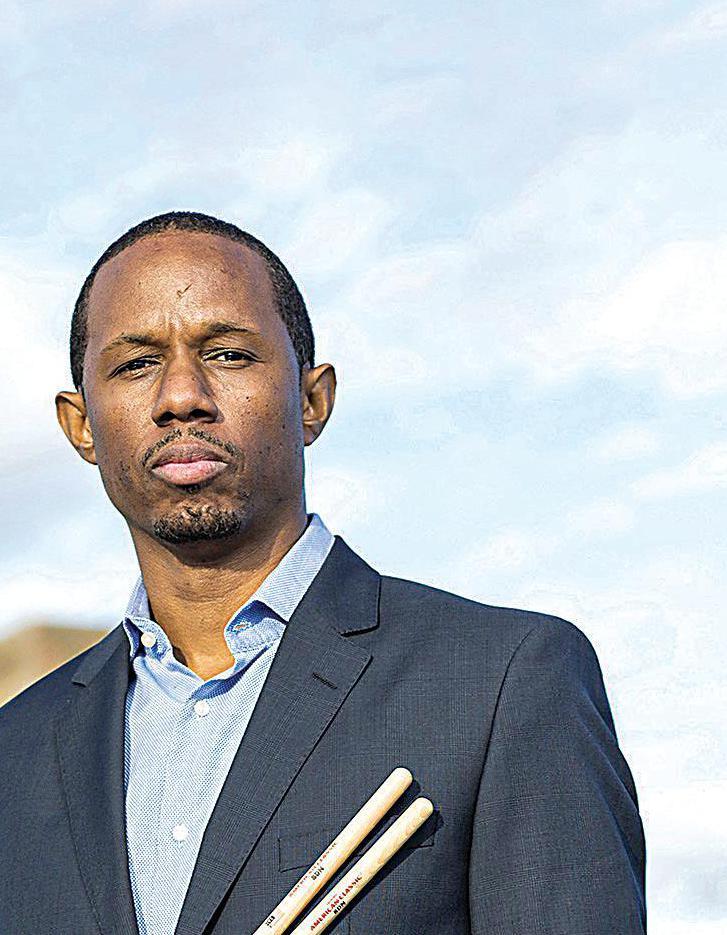
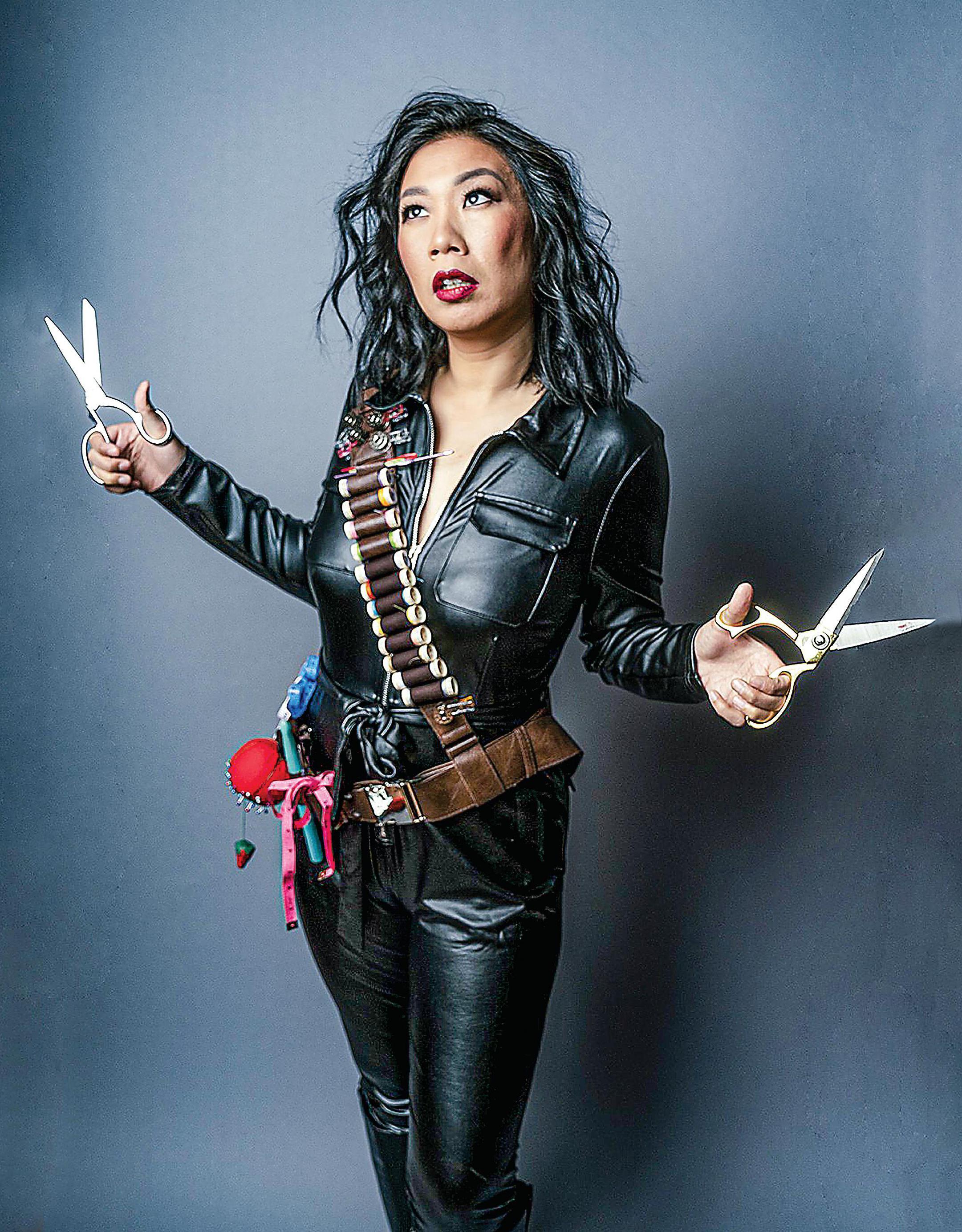 When he didn’t get signed to a record label, jazz drummer Willie Jones III created one.
When he didn’t get signed to a record label, jazz drummer Willie Jones III created one.







 When he didn’t get signed to a record label, jazz drummer Willie Jones III created one.
When he didn’t get signed to a record label, jazz drummer Willie Jones III created one.
After drumming with distinction in the bands of such jazz greats as Horace Silver, Milt Jackson, Roy Hargrove and Arturo Sandoval, Willie Jones III was eager to land a contract with a major record label for his audacious 2001 debut album, “Vol. 1 ... Straight Swingin’.”
The fact that he didn’t may well be the best thing to happen to this enterprising Los Angeles native. He will open the La Jolla Athenaeum’s three-concert fall series on Sept. 29 with his band, which features former “Tonight Show” saxophonist Ralph Moore and San Diego trumpeter Gilbert Castellanos.
“My not getting signed is a great thing,” agreed Jones, speaking from the Brooklyn home he shares with his wife, Zooey.
Things worked out, the way they were supposed to, for the best.”
Jones created his own record label, WJ3, to put out his debut album. He has since made six more albums as a band leader for his homegrown label.
WJ3 has also released 15 albums by such artists as guitarist Jacques Leisure, pianists Eric Reed and Cyrus Chestnut, and saxophonists Teodross Avery and Justin Robinson. Each of them shares the devotion of WJ3’s founder to making music that celebrates and extends the hardbop and straight-ahead jazz traditions Jones has embraced since his teen years.
He is in good company with his boutique label, which is helping extend a key chapter in the jazz continuum.
Other artists who maintained control of their music by launching and operating their own record companies — for varying periods of time — range from Lionel Hampton, Dizzy Gillespie and Duke Ellington to Mary Lou Williams, Sun Ra and Dave Douglas.
“I had the opportunity to talk with (drum legend) Max Roach about the record label he and Charles Mingus started together in the 1950s,” Jones said. “And my father told me about how it’s always best to have control of what you do.
I tried to get a record deal, including with a label I had done a lot of recording for as a sideman, but to no avail. Now, I’m like, ‘Why would I want to record for someone else, when I’ve already done the legwork and am building a catalog featuring some of the same musicians who record for major labels?’ I’m more determined than ever to go down this road.”
Jackson to Lamar
That road has been a constant and multifarious one for Jones.
His past collaborators range from Herbie Hancock, Sonny Rollins and the Dizzy Gillespie All-Star Big Band to Michael Brecker, Ernestine Andrews and Bobby Hutcherson. His teachers and mentors have included such
storied drummers as Billy Higg ins, Albert “Tootie” Heath and Leon “Ndugu” Chancler, who is saluted on the drum-fueled opening track of Jones’ most recent WJ3 album, “Fallen Heroes.”
That opening track is a solo feature for Jones. He built it around the brief but propulsive drum figure Chancler played at the start of “Baby Be Mine,” a deep album cut on Michael Jackson’s “ Thriller” album.
“What Ndugu played on that always felt like a jazz drum fill to me, but then the song went straight into a funk groove,” Jones explained. “It still made sense he played that figure for the opening f ill, because — at the heart of things — Ndugu was a jazz drummer.
Not long after he passed (in 2018), I began playing that figure in tribute to him at the start of my drum solos. It developed to the point where I thought, ‘Maybe I could make this a drum feature.’
For the recorded version, I started off playing his phrase and then improvised off of it.”
Chancler was not the only musician Jones admired whose death inspired the title and music on his latest album.
“ The overall concept of the recording was to salute some of my fallen heroes,” Jones explained.
Within a two-year span, we in the jazz community lost five musicians that were very close to me and very pivotal in my musical development. Specifically, (trumpeter) Roy Hargrove, Ndugu, (pianist) Larry Willis, and (saxophonists) Jeff Clayton and Jimmy Heath.”
Jones also counted Hargrove, Heath and Willis as longtime musical collaborators. Accordingly, the drummer’s latest album features spirited new arrangements of songs by Hargrove (“Trust”), Heath (“C.T.A.”) and Willis (“Annika’s Lullaby,” “To Wisdom, The Prize” and “Fallen Hero’s” title track).
He is accompanied on the nine-song recording by such veteran musicians as pianist George Cables, trumpeter Jeremey Pelt, singer Renee Neufville and saxophonist Sherman Irby, as well as by rising pianist Isaiah J. Thompson.
Whether it’s younger or older musicians, if I hire them, I already know and respect how they play,” Jones noted.
“If they are younger and I’ve never played with them before, I may make a suggestion, like: ‘This is a possibility. You don’t have to do this, but this is an option.’ If it’s an older musician who I haven’t played with before, I don’t need to do that because they are so much more experienced than me.”
Willie is the real deal,” said San Diego trumpeter Castellanos, who met Jones when both studied at Cal Arts in the early 1990s. They soon became bandmates in Black Note, which made several majorlabel albums and toured the world. The two have since collaborated as often as possible, both before and after Jones moved to New York in 1997.
“Even back in college, Willie was ready to be anyone’s drummer,” Castellanos said. “He did his homework and would learn everyone’s music. That’s why he got the g ig with Roy Hargrove; he knew every Hargrove tune, inside out. I not only consider Willie to be a great drummer, but a great musician, band leader and composer. He has perfect pitch and really knows the music.”
Castellanos laughed.
“Willie would call me out during Black Note rehearsals, and say, ‘No, no, that’s not the right note.’ I’d say, ‘Yes, it is.’ Then, he’d play it on the piano or play the record, and I’d be like: ‘Oh, shoot! I am playing the wrong note.’”
Given his roots, it would have been surprising if Jones did not become a musician.
His father was the pianist and music director for the popular singing group The Platters and later became the vocal coach for actress Ann-Margaret
An accomplished jazz musician, the elder Jones would hold band rehearsals in his family’s home. And he would often take his music-obsessed young son to club g igs and recording sessions.
“When I was a kid, my father wanted me to learn the piano,” Jones said. “And now, I wish I did and wish I’d had the discipline. I just gravitated toward the drums and loved playing them.
“I didn’t get really serious about practicing until I was in high school. But from grade school on, I put on records or turned on the radio and tried to play along. If I was watching a basketball game on TV, I’d have my practice pad and drum throughout the game.”
By the time he was 18, Jones was doing paid club dates, sometimes thanks to his father hiring him.
“I really shouldn’t have been on some of those gigs,” Jones said. “But that was my father’s way of getting me that experience, which
was very pivotal in helping me. To be on the bandstand for a whole set inspired me. I was like, ‘OK, I want to do more of this!’”
Much more is exactly what Jones has done since then, as his steady stream of concerts, club dates and recording sessions attests. Witness 2019, his last full year of performing before the COVID-19 pandemic shut down concerts around the world.
During that 12-month period, he performed multiple gigs with his quartet and quintet. He did concert and club dates as the drummer for pianist Bill Charlap, singer Roberta Gambarini, saxophonists Houston Person, Javon Jackson and Steve Wilson, and at least half a dozen other artists.
Jones’ 2019 schedule also included a U.K. tour as the drummer for English pianist Trevor Watkis and a U.S. tour with the Wynton Marsalis-led Jazz at Lincoln Center Jazz Orchestra. In between live dates, he worked on ideas for some of the music featured on his 2021 album “Fallen Heroes.”
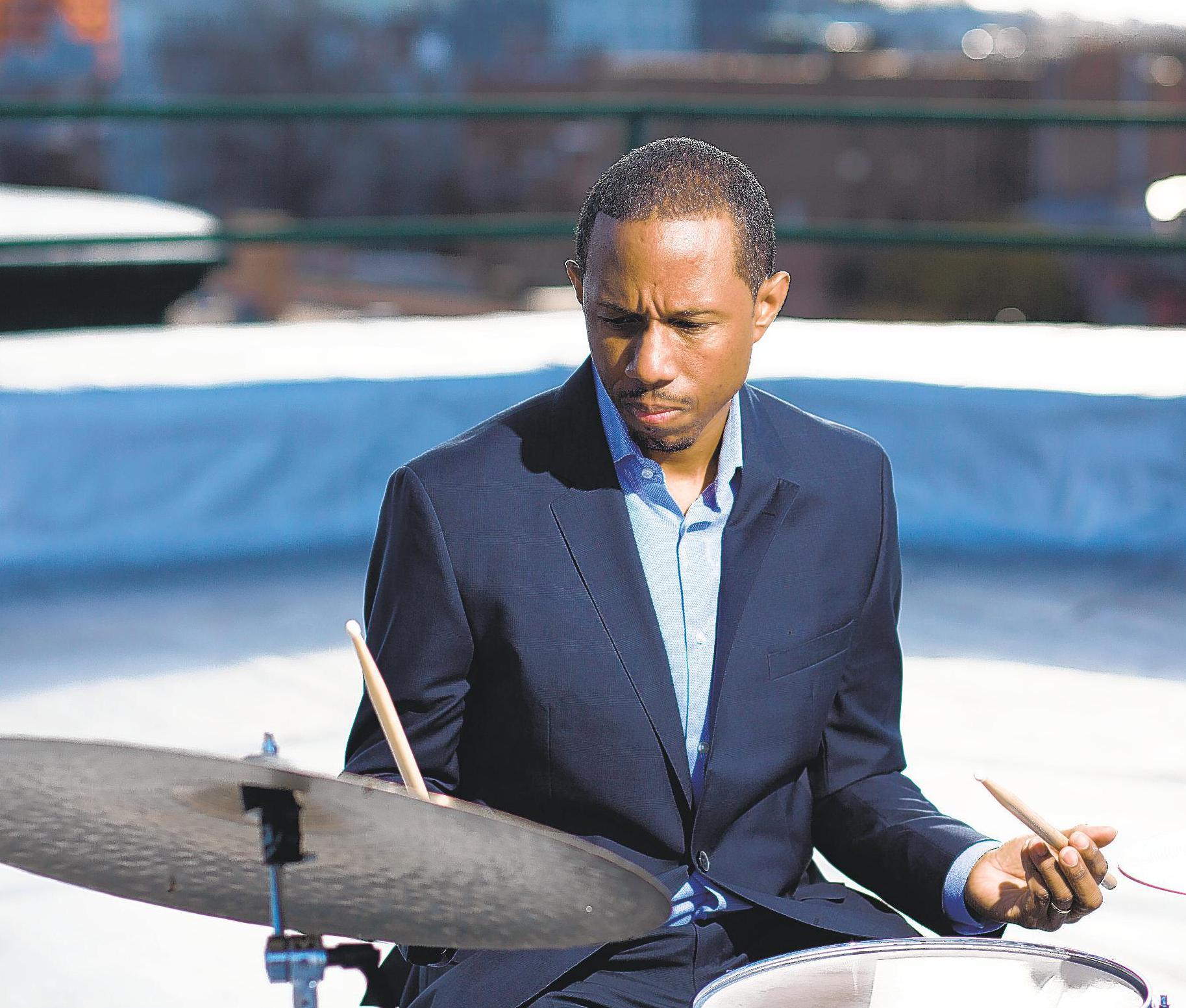
No matter the setting, his crisp drumming stands out for the tastefulness, imagination, dynamic control and infectious sense of buoyancy he brings to the music.
Whoever the artist I’m playing with is, I try — to the best of my ability — to bring whatever their vision is for the music,” said Jones, whose instrumental “The Thorn” was sampled on Pulitzer Prizewinning rapper Kendrick Lamar’s song “Rigamortus.”
“I try to interpret the music, rhythmically, as closely as possible to what the artist I’m working with is hearing or feeling, and to whatever concept or vibe they tell me they are looking for,” he continued.
I try to do that while still expressing my voice, musically, and that’s always a good challenge. But that’s the ultimate goal — to be able to go into a musical situation and articulate what they want and are hearing, while still expressing my musical voice. I have an extreme love for music and for playing the drums. No matter what the gig is, I give 110 percent to make the music take off.”
Since Jones readily admits he eschewed piano lessons as a kid, what instrument does he compose music on for his albums and the various bands he leads?
“ The piano,” Jones replied, laughing heartily. “And it’s a slow, painful process!
Where: Joan & Irwin Jacobs Music Room, Athenaeum Music & Arts Library, 1008 Wall St., La Jolla
Tickets: $40 per concert for members and $45 for nonmembers; series tickets are $114 for members and $129 for nonmembers
Information: (858) 454-5872, or ljathenaeum.com
To this day, when I write it’s completely by ear, which is a good thing. I write by trial and error, and I feel confident with the finished product. But to get there, I go strictly by ear, basically banging on the keys until I hear something I like. That can take weeks, or months. And then I’m like, ‘OK, great. I have four bars of music!’”
“I tried to get a record deal but to no avail. Now, I’m like, ‘Why would I want to record for someone else, when I’ve already done the legwork and am building a catalog featuring some of the same musicians who record for major labels?’ ”Willie Jones III BY LIZ GOLDNER
Few artists’ works exemplify the Southern California proclivity to merge images with text, found objects and Hollywood memorabilia as much as the oeuvre of Alexis Smith, the subject of a new exhibition, “Alexis Smith: The American Way,” at the Museum of Contemporary Art San Diego in L a Jolla.
As this show of 50 collages, assemblage pieces and installations from the 1970s to the 2010s demonstrates, Smith has unearthed our cultural touchstones, stories and myths and artistically recreated them. Her collage “Degree of Difficulty” (2005) juxtaposes a photo of the vibrant Britney Spears from a Pepsi ad with a picture of the aging Shirley MacLaine from “Modern Maturity” and a photographic calling card of a female prostitute. With each image partially concealed by a geometric shape, the piece alludes to the objectification of women — the sexy young thing, the old woman, the sex worker — in contemporary society.
Smith has remarked that her art pieces are “ about the normal things that have to do with the experience of 20thcentury existence and a separate subtext of looking for meaning in life. You have to read into each piece for yourself; there is no correct interpretation, no right answer. The art is something that happens in your head.”
The assemblage “Men Seldom Make Passes at Girls Who Wear Glasses” (1985), also evolving from Smith’s intuitive artistry, takes its title from 20thcentury writer Dorothy Parker’s famous two-line poem. The artwork includes a large portrait of Marilyn Monroe, painted directly onto a gallery wall, wearing collaged sunglasses, featuring photos of football players and the Parker poem. The wildly attractive installation — depicting the movie star making men the focus of her desires, rather than the converse — becomes a magnet for art viewers.
Smith, born in 1949 in Los Angeles, not only transformed and reinvented her own life through her artwork, but her numerous collages and installations have helped advance our understanding of how culture, politics and life intersect. She once said: “I happen to feel affectionately toward popular culture because I am part of it. … I think my work is a very weird hybrid of old-time assemblage and a hands-on concern for battered objects that are poignant, mixed with a literacy and a conceptual point of view.”

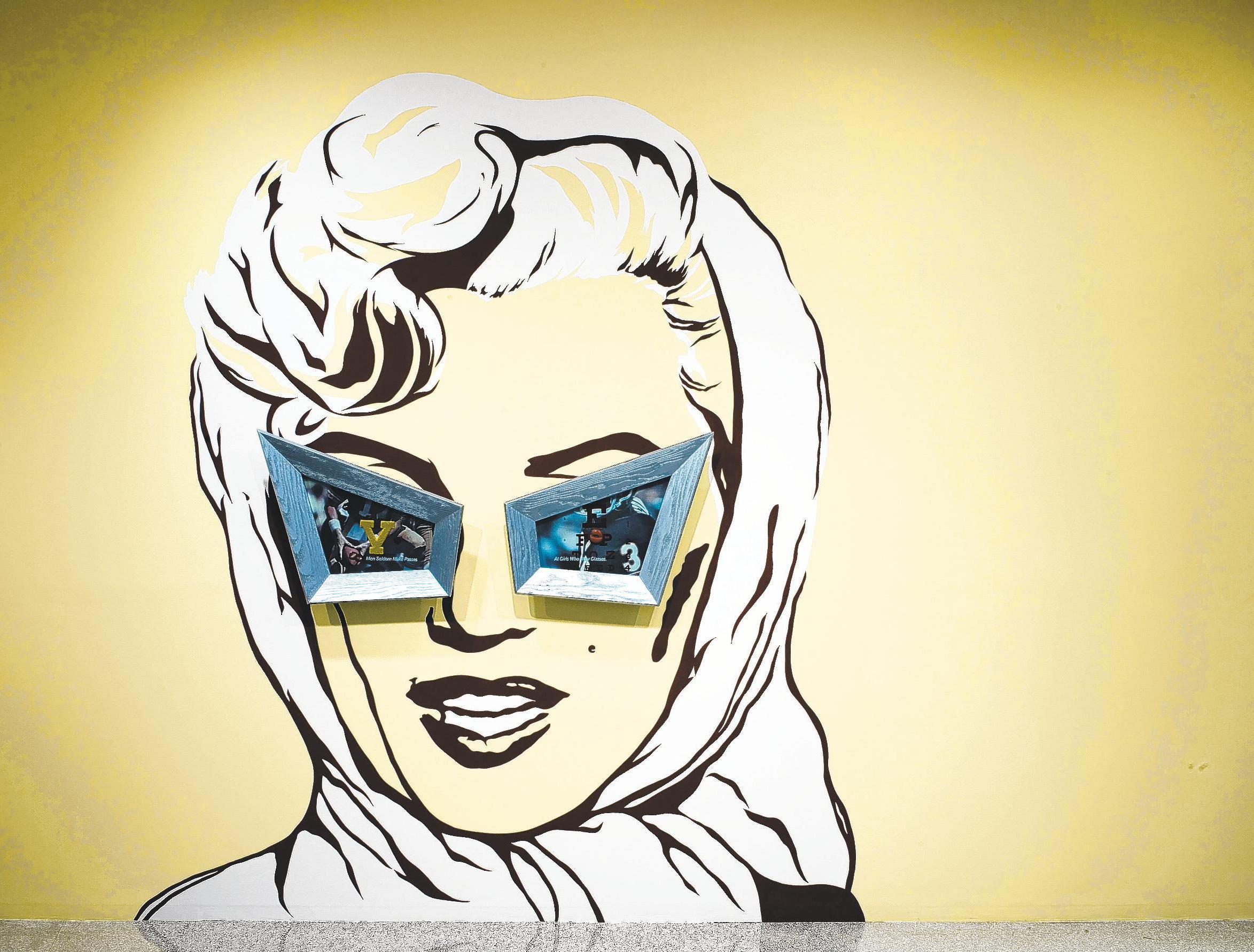
Smith’s imaginative approach to art-making was a product of her personal world view, influenced in part by growing up with a psychiatrist father, when she began creating collaged books, and by her four years studying at the thenrecently-opened University of California Irvine art school (she graduated in 1970).
In that Orange County outpost, artist instructors, including Tony DeLap, Robert Irwin, Craig Kauffman, Vija Celmins and Ed Moses, empowered students to think and behave like professional artists, employed unusual teaching methods such as having them put crayons between their toes, collaborated on performance pieces, and even partied with them.
While this New Age educational approach mystified some students, Smith embraced and boldly executed its paradigms, resulting in her ever-expanding artwork being recognized and exhibited by local, national and international art venues.
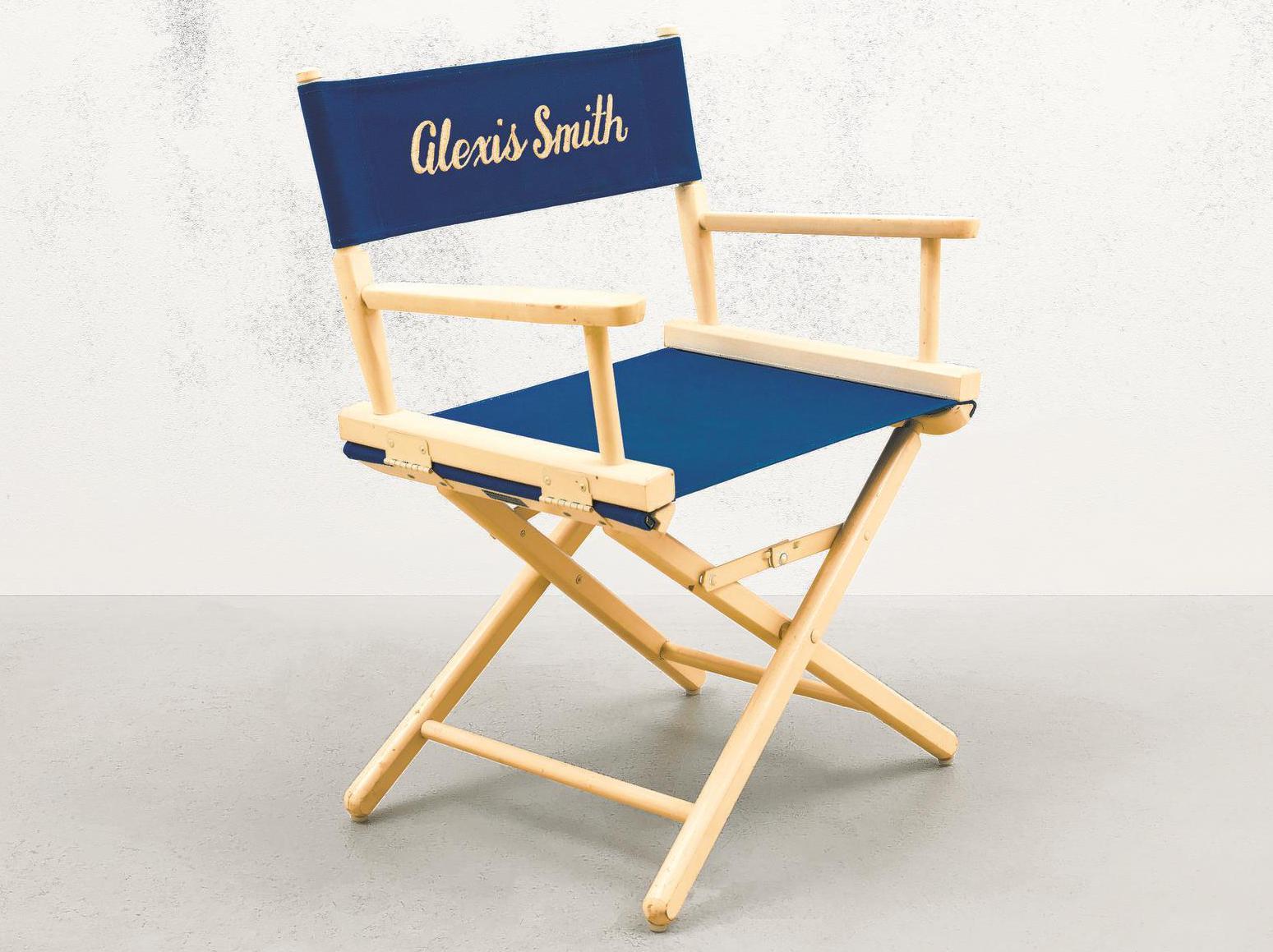
One of her admirers is Anthony Graham, associate curator at MCASD and curator of the Smith exhibition. He featured her 1980 collage “The American
Way” in the museum’s 2016 show “Selections From the Collection.” He realized then that Smith had not had a major museum show in several years.
“With our strong holdings of her work and her impressive public artwork nearby, we are a fitting institution to showcase her career-long work,” he says. (Two of her public pieces, “Same Old Paradise” (1987), a 62-foot-long mural of a quaint village with rolling hills threatened by an ominous snake, and “Snake Path” (1992), a meandering 560-footlong walkway, are displayed at the University of California San Diego.)
Graham adds: “I visited Alexis’ artist’s studio in 2017 in Venice, California, where I met her, Scott Grieger, her husband, and Erin Calla Watson, her studio manager. We have all worked together to capture the complexity and nuance of her expansive body of work — presenting her early, intimately scaled collages, and recreating several of her large, immersive installations for this current exhibition.”
Smith’s “The American Way” assemblage on aluminum plate — featured in the current MCASD show — contains symbols of Americana, including a Coke bottle, a crossword puzzle, play money and a bra.
“ The piece is enigmatic with its combination of text, image, found objects and screen-printed images,” Graham says. “These juxtapositions come together into poetic combinations that capture and amplify the energy of one another, creating individual associations in the heads of the viewers.”
Other artworks in this Alexis Smith retrospective are multipanel storytelling collages, affixed to scenes painted directly onto the gallery walls. Among these is the re-creation of a group of installations, named “Raymond Chandler’s L.A,” first shown in a Los Angeles gallery in 1980. Collages from the series, titled “Hello Hollywood,” “Golden State,” “Downtown,” “Sunset” and Tightrope,” include quotes from Chandler’s novels, which capture the noir aspects of the older Hollywood. He also worked as a movie screenwriter, and some of his books were later adapted into movies.
The backdrops to these exhibits include abstracted city skylines, roadside ads and telephone poles of decreasing height, evoking the steadily receding perspective while driving. For fans of the Chandler novels and films, these settings may suggest Detective Philip Marlowe driving through Los Angeles and Hollywood, while ruminating on unsolved cases.
These Chandler-influenced works are complemented by other film-inspired collages, including “Easy Rider,” “Midnight Cowboy,” “The Red Shoes” and “The Girl Can’t Help It,” the latter with its title from a 1965 Jayne Mansfield f ilm. The Smith collage, “Madame Butterfly,” references the opera of that name. These ingenious creations contain movie and theater artifacts, along with images and text.
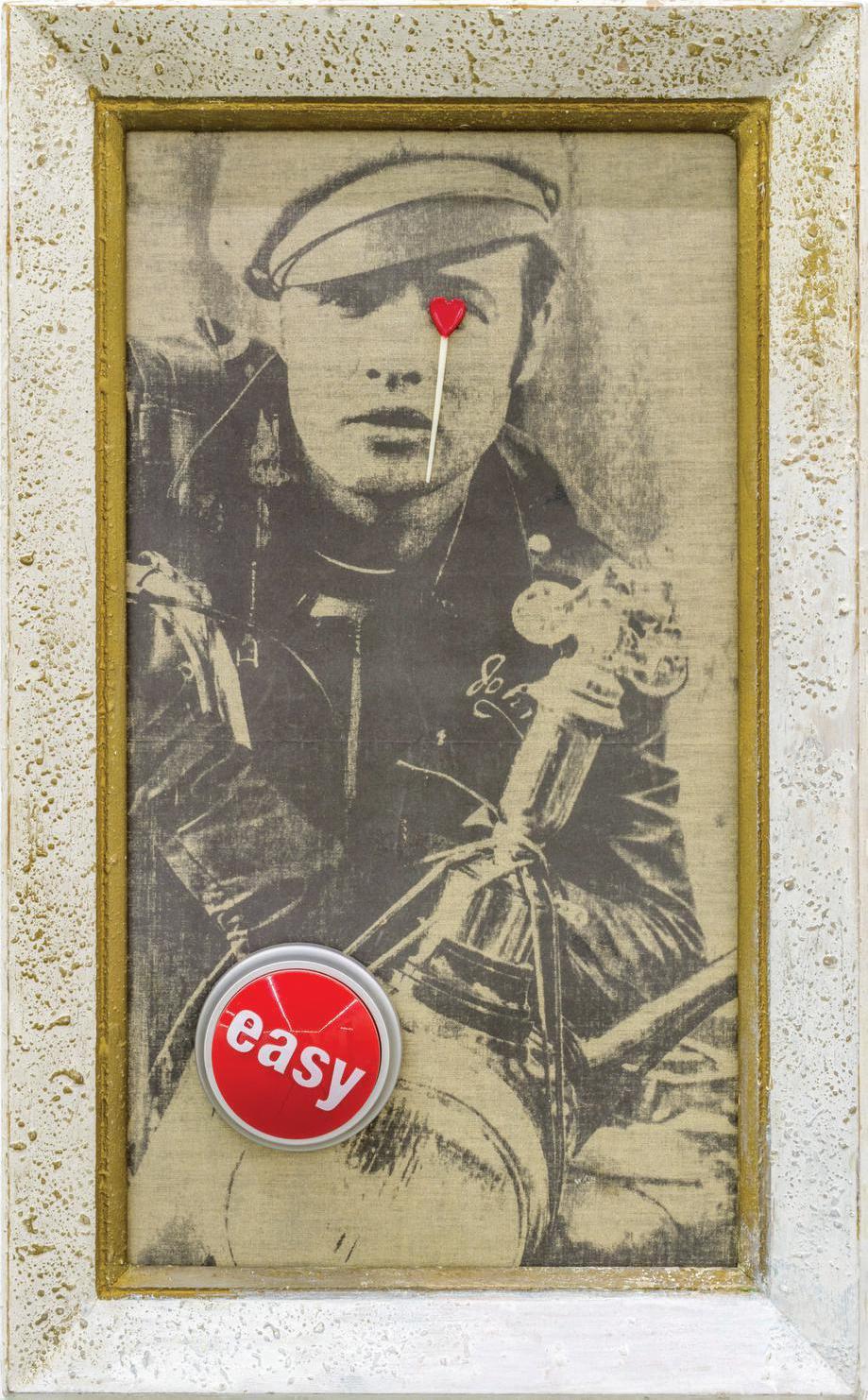
The American Way” follows MCSAD’s recent “Niki de Saint Phalle in the 1960s” exhibition with work by the spirited artist from the prior generation. Indeed, both Saint Phalle and Smith have mined their personal life experiences, transforming them into formidable bodies of work, with many of their pieces addressing dilemmas of contemporary women.
The sense of freedom resonates throughout Alexis Smith’s work, the resistance to convenient art-historical categories, her ability to continue changing and expanding the formal strategies of collage, even the difficulty of situating her work in relationship to her own biography,” Graham says in the exhibit’s catalog. “But
“Sugar Street” by Jonathan Dee (Grove): A man with $168,548 hidden in an envelope under the seat of his car is on the road and off the grid. The money is all he has from a former life he is determined to abandon. As he avoids modern surveillance, his life is stripped down to the basics: a roof over his head with a landlord who won’t ask questions and food from a cameraless mom-and-pop market. Pulitzer Prize finalist Dee’s edgy literary thriller considers what a privileged White man seeking a guilt-free life might do when he is on the run from himself.
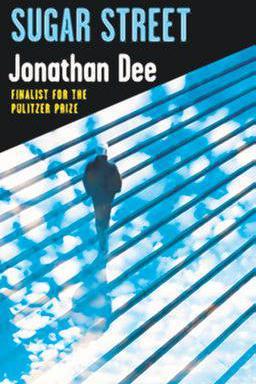
“How Not to Drown in a Glass of Water” by Angie Cruz (Flatiron): Twelve sessions with a job counselor provide the framework for Cruz’s endearing portrait of a fierce, funny woman whose 26-year career at “the factory of little lamps” has abruptly ended. To keep receiving checks from “El Obama,” she must look for work, but her résumé is thin despite extensive life experience. At each session, she shares more of her life story, her loves and marriage, how she’s affected by gentrification in Washington Heights, her crushing medical debt, and the reason she fell out with her son.
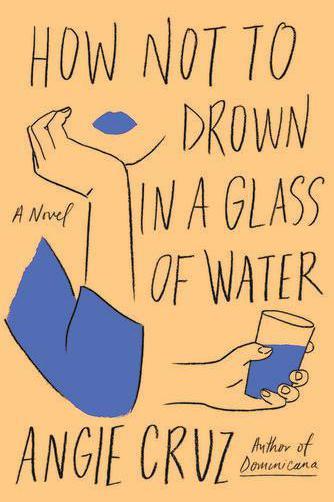
Fiction
1. “Carrie Soto Is Back” by Taylor Jenkins Reid (Ballantine) 2. “The Ink Black Heart” by Robert Galbraith (Mulholland) 3 “Other Birds” by Sarah Addison Allen (St. Martin’s) 4. “All Good People Here” by Ashley Flowers with Alex Kiester (Bantam) 5. “Daisy Darker” by Alice Feeney (Flatiron) 6 “The 6:20 Man” by David Baldacci (Grand Central) 7. “The Hotel Nantucket” by Elin Hilderbrand (Little, Brown) 8. “Lessons in Chemistry” by Bonnie Garmus (Doubleday) 9. Babel” by R.F. Kuang (Harper Voyager) 10. “The Midnight Library” by Matt Haig (Viking)
Nonfiction 1. “I’m Glad My Mom Died” by Jennette McCurdy (Simon & Schuster) 2. “Breaking History” by Jared Kushner (Broadside) 3. “Diana, William, and Harry” by James Patterson and Chris Mooney (Little, Brown) 4. “Path Lit by Lightning” by David Maraniss (Simon & Schuster) 5. “Crying in H Mart” by Michelle Zauner (Knopf) 6. “Finding Me” by Viola Davis (HarperOne) 7. “Life on the Mississippi” by Rinker Buck (Avid Reader) 8. “Think Again” by Adam Grant (Viking) 9. “What Happened to You?” by Bruce D. Perry and Oprah Winfrey (Flatiron) 10. “An Immense World” by Ed Yong (Random House)
Even for those of us who remember them all too well, the 1990s were something of a muddle.
The decade was like a long transitional moment between the casually rapacious spirit that preceded it and the War on Terror that came after.
The Clinton administration may have shown that the American political center of gravity had shifted to the right, with a Democratic president signing a punitive crime bill in 1994 and making good on his pledge to “end welfare as we know it.” But part of the confusion over the ’90s seems to lie in the discrepancy between what was actually happening and the soothing language that was used to describe it — bland clichés about a postCold War consensus, with establishment politicians coalescing around “the end of history” and “the third way.”
So much for all that. As the historian Nicole Hemmer writes in “Partisans,” her lively and clarifying new book, the conservative movement of the 90s was doing much more than biding its time. Unlike Dana Milbank’s “The Destructionists,” which also looks closely at the Republican Party during the ’90s, “Partisans” is less a prehistory of the Trump presidency than an autopsy of the short-lived Reagan era.
distinct wasn’t his conservatism, with its hodgepodge of small-government libertarianism (less money for education) and big-government anti-communism (more money for the military). Hemmer locates Reaganism’s core in his particular style: flexible, pragmatic, relentlessly cheerful.
Reagan got castigated by plenty of conservatives. In 1984, Rep. Newt Gingrich of Georgia railed against the president for being too focused on “governing” and too enamored of unity, when he should have been “forcing a polarization of the country.” A decade later, as the House minority whip, Gingrich would engineer a landslide victory for Republicans that would elevate him to speaker of the House.
Gingrich is just one of the f igures in this book who contributed to Reaganism’s demise by fueling a populist right. Not that Gingrich himself was much of a populist in any real sense, spouting incendiary rhetoric to fire up the base while quietly compromising on legislation behind the scenes. Among conservatives, Gingrich was considered enough of a sellout that he was widely distrusted, even by the likes of his fellow showboat Rush Limbaugh.
partisans — previously relegated to the margins — could get their share of the spotlight.
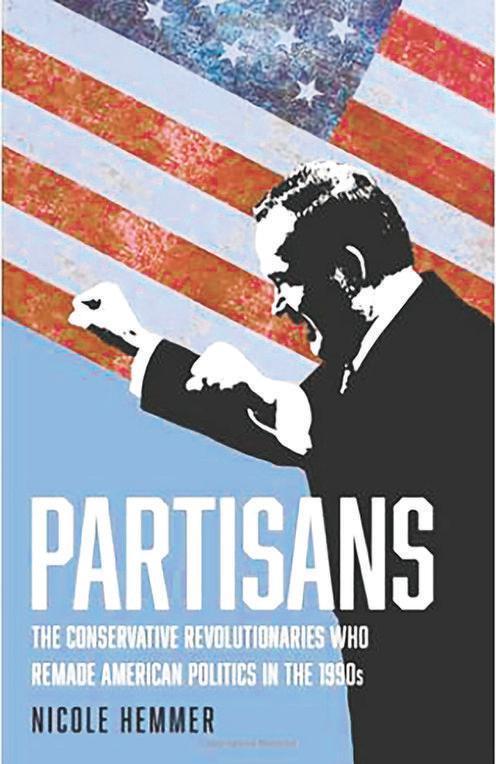
The main partisan in Hemmer’s narrative is Pat Buchanan. Despite serving as the communications director in the Reagan White House, Buchanan wasn’t a buoyant Reaganite but a grievance politician — an anti-immigration isolationist who attracted Klan support (which he did little to rebuff) and, as Hemmer puts it, “dabbled in Holocaust denial.” He declared his admiration for Francisco Franco, the Spanish dictator, and South Africa’s apartheid regime.
ADVENTURES BY THE BOOK, (619) 300-2532, adventuresbythebook.com
Virtual: Fall Into Reading (Part 6): A six-part virtual Fireside Adventure featuring Sara Ackerman, Jamie Beck, Carol Van Den Hende, Madeline Martin, Ellen Meeropol and Gill Paul, 4 p.m. Thursday.
MYSTERIOUS GALAXY, (619) 539-7137, mystgalaxy.com
Virtual: Kevin Hearne discussing “Iron Druid Chronicles,” 7 p.m. Monday.
In-person and virtual (ticketed): Susan Lee (“Soulmates”) in conversation with Christina Lauren, 6 p.m. Tuesday.
Virtual: Gary Phillips, Tananarive Due and Jervey Tervalon discussing “South Central Noir,” 6:30 p.m. Thursday.
In-person: John Mullen discussing “Nell: Marshal of Bodie,” 2 p.m. Saturday.
WARWICK’S, (858) 454-0347, warwicks.com
In-person: Weekends With Locals: Mark James discussing “The Interview Mindset: The Ultimate Guide to Mastering Your Career,” today at noon.
Virtual: Jeffrey Breslow (“A Game Maker’s Life”) in conversation with Cynthia Beebe, 4 p.m. Tuesday. In-person: Rolf Benirschke discussing “Saving Wildlife,” 7:30 p.m. Tuesday.
Virtual: In partnership with Coronado Public Library: Craig Johnson discussing “Hell and Back,” 7 p.m. Wednesday. Coronado Public Library’s Winn Room, 640 Orange Ave., Coronado
In-person: In partnership with University of San Diego’s College of Arts and Sciences: Scott Turow (“Suspect”) in conversation with Stephen Ferruolo, 7 p.m. Thursday. Grace Courtroom, Warren Hall at USD, 5998 Alcala Park, San Diego
Reagan’s victory was supposed to mark a turning point for Republicans, toward a conservatism that was “optimistic and popular,” Hemmer writes. Sure enough, Republicans still like to invoke Reagan’s name. But Hemmer shows that Reaganism as an ideology and an attitude collapsed almost as soon as he left office; his name became a mantra without actual meaning. What happened, and why did it happen so quickly?
When Reagan first ascended to the White House in 1981, what made his approach
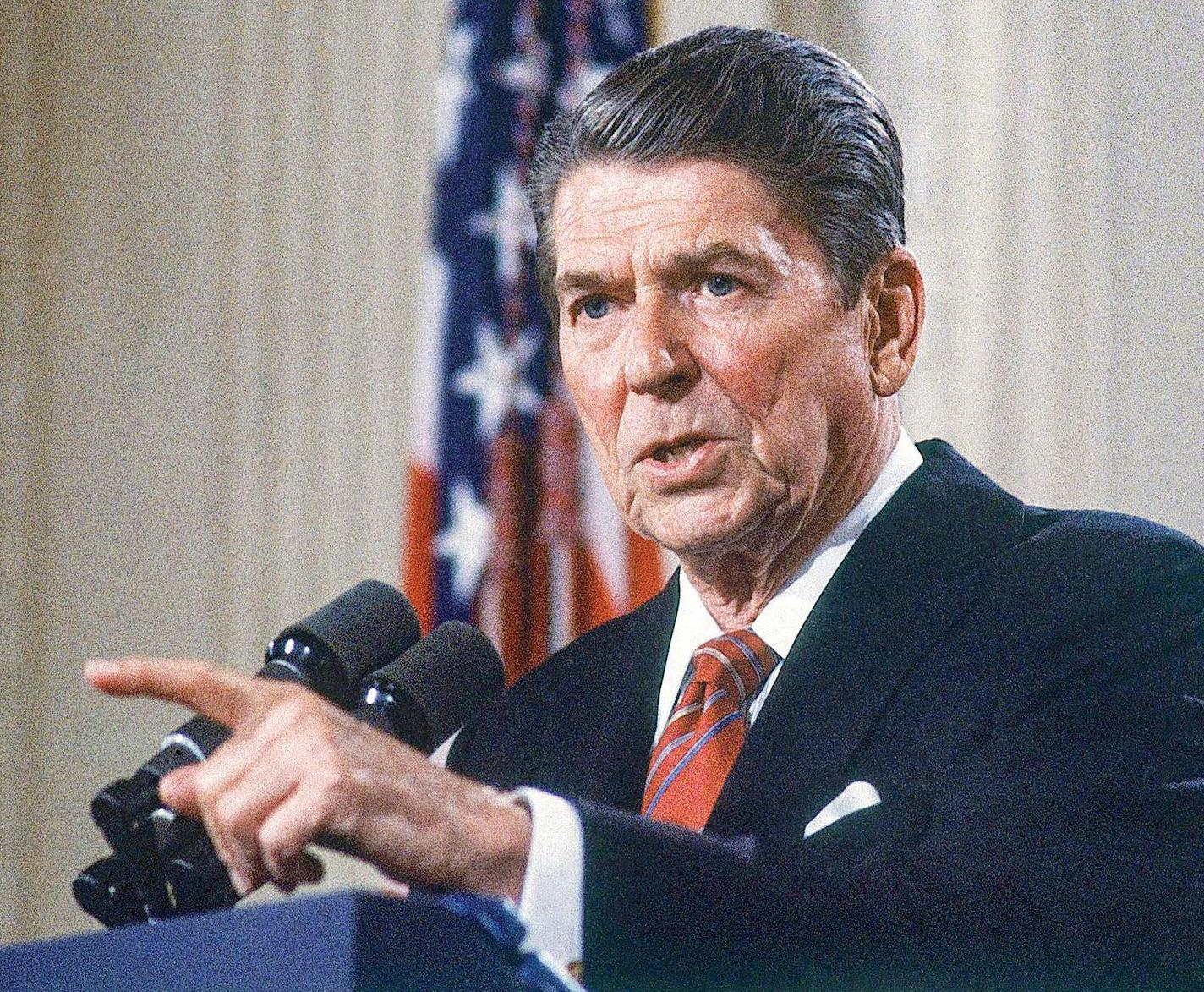
Reagan hated to be associated with any policy that was unpopular, retroactively trying to pin the blame for slashing the funding for school lunches on a bureaucracy that was out to get him (“none of this was true,” Hemmer writes). He was open to immigration reforms and liked free trade. His faith in the revenuegenerating magic of tax cuts was a reflection of his sunny outlook — tides would rise, boats would lift (only they didn’t, and after cutting taxes inflated a ballooning deficit, he raised them again).
While some Republicans found the Reagan presidency winning, others found it infuriating. Hemmer reminds us that despite the mythology that has flourished since,
Job: Bookseller and book crate subscription coordinator, Mysterious Galaxy
She recommends: “Babel: Or the Necessity of Violence: An Arcane History of the Oxford Translators’ Revolution” by R.F. Kuang (Harper Voyager, 2022; 560 pages) Why? Orphaned and plucked from his native land of Canton, all Robin Swift has ever wanted was to find a home. Upon arriving at Oxford, Robin soon discovers that there is a glass ceiling for people like him, and that a Babbler’s worth is dependent on their knowledge serving the expansion of the British Empire — by conducting silverworking, the art of using magic to uncover meaning lost in translation. Kuang’s cast of characters recalls the intense, complex relationships between the cohort of Donna Tartt’s “The Secret History,” while also grappling with identity, agency, revolution and anti-colonialism. Devastating and vast in its emotional and thematic scope, “Babel” breaks down language to its bones, twists it, and infuses it with magic in a way that will stay with you long after you turn the last page.
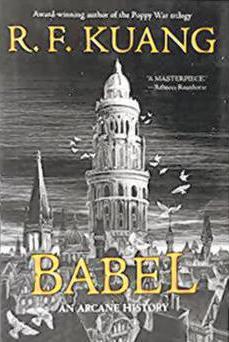
Hemmer, whose previous book traces the history of conservative media, devotes a substantial swath of “Partisans” to the way that the media ecosystem changed in the ’90s. Limbaugh’s radio show was nationally syndicated, propagating his mix of clowning and rage. Fox News fixtures like Laura Ingraham and Tucker Carlson had their careers nurtured by MSNBC. Bill Maher’s talk show “Politically Incorrect,” though brimming with ridicule for both Democrats and Republicans, was especially welcoming of g uests like Ingraham, because saying offensive things was apparently entertaining — at least according to Maher, who had declared he wanted a show that “made controversy funny.”
Maher wasn’t so much a partisan as a contrarian; but like Ross Perot, another contrarian in Hemmer’s book, Maher turned out to be an inadvertent enabler, helping to shake things loose, opening enough space so that the real
Buchanan tried and failed to get the Republican nomination twice, and ran as a thirdparty candidate in 2000. But just because he didn’t succeed in the immediate sense doesn’t mean that he hadn’t planted a seed. “His politics were already taking root in the institutional structure of the Republican Party,” Hemmer writes, describing how the party’s platform was amended in 1992 to include one of Buchanan’s demands — “structures” on the southern border.
But the finer points of policy — or “governing,” as Gingrich derisively put it — seemed to have little to do with the conservative transformation that was taking place. The overall sense you get from Hemmer’s book is that none of Bill Clinton’s maneuvering during the ’90s, including his frequent tacks to the right, made conservatives feel heard; if anything, Republicans just “lurched further to the right themselves,” Hemmer writes, “rejecting compromise in favor of perpetual warfare.”
Reading about how the performance of grievance can harden, I was reminded of that old warning given to children (1990 was probably the last time it was given to me): Keep making that face and it’ll freeze that way.
Job: Youth Materials Selector, Collection Development, San Diego County Library
They recommend: “The Magic Fish” by Trung Le Nguyen (New York: RH Graphic, 2020; 229 pages)
Why? The 2022 One Book One San Diego Teen selection is a graphic novel of family, fairy tales, loss and love. Tien bonds with his mother, Helen, by sharing his favorite fairy tales to help her improve her English. He’s also struggling to find the words to tell her he’s gay, but she is suddenly called back to Vietnam when her own mother dies. There, we learn that Helen struggles with her own feelings of disconnection from her family in Vietnam while she forges a new life in the U.S., and that using fairy tales to express one’s inner self is a tradition in her family. Tien’s story is interspersed with three beautiful fairy tales that reflect Tien and Helen’s hopes and fears on their journey of understanding. This lyrical, peaceful story will resonate with everyone who has ever felt like an outcast or misunderstood by the world.
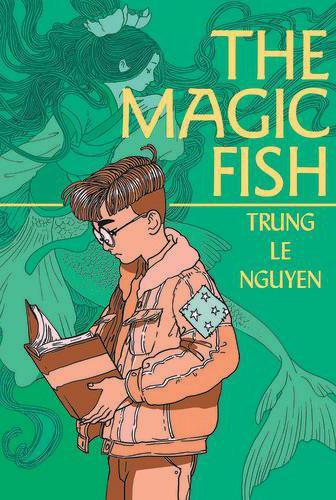
My little brother often asks me this when I’m struggling to make a decision, despite the fact that I am about to enter my senior year at the University of California San Diego.
I started my freshman year in 2019 and had a glorious six months of newfound freedom living on campus before getting sent home in March 2020 for what many around me celebrated as an extended spring break.
It seemed too good to be true. Finals were put online, homework was being waived, and I was too preoccupied browsing cheap flights abroad to comprehend the magnitude of what was going on.
That first year of college, I worked hard to build friendships and get to know the people in my classes. I became somewhat of an extrovert, always busy, surrounded by people and putting myself out there. I think this is what my brother means when he refers to “College Zara” — a more confident and carefree version of myself. But when all of that excitement came to a halt so quickly, it was jarring. “College Z ara” got shoved to the side at the onset of the COVID-19 pandemic, and in its place, uncertainty and insecurity took over.
I felt the ache of my new life being snatched away as I moved back into my childhood home and away from my friends, but after a few months,
it dulled away. Although the sound of my brothers’ 9 a.m. band rehearsals did interfere with my discussion-based classes, and my mom made a number of cameos in the back of my Zoom screen, it wasn’t all that bad. I got to wake up late, watch lectures in sweatpants and munch on snacks whenever I wanted. I thought that adjusting to “Zoom University” would be the most difficult part of the pandemic, but it felt surprisingly easy to fall back into old patterns of comfort.
The real wake-up call was when classes resumed in person. UC San Diego had a handful of in-person labs during the 2020-21 school year, but it wasn’t until fall of 2021 that a majority of the students, including myself, returned for in-person classes.
That first day back felt cathartic. Part of me, of course,
was relieved and excited to be returning to a degree of normalcy on campus. But I couldn’t shake an overwhelming sense of anxiety about pretty much everything: germs on tables, speaking in class, making small talk with the person next to me. I had lost my footing, and despite the rational logic that the pandemic was, to an extent, a universal experience of loss for students, it felt isolating. Everyone around me appeared to have moved on and adjusted to this new normal, but I was still stunted by setbacks and clawing for my older self.
A study conducted by Penn State University found that 72 percent of students seeking mental health services reported that their mental health had been negatively impacted by COVID-19. I found myself among the 72 percent.
I had dealt with anxiety for years, but the pandemic elevated it to a new level. Even the smallest of things like taking my mask off to drink water would make me nervous.

Part of the worry was definitely related to COVID-19. In such unprecedented times, despite UC San Diego’s best efforts to ensure a clean and safe learning environment, I wanted to be extra cautious. But I also hid behind my mask. I had gotten so used to not seeing people’s faces and not having others see mine that I developed insecurities about how I looked without a mask. I felt safe hiding behind it, relieved of worries about whether my skin looked good or if I was making a strange face.
I don’t remember having so many insecurities before the pandemic. Quite honestly, I don’t think I had the time to ponder over myself that much. But now I’m left with a hyperawareness of how I present myself to others, and it feels so much easier to control that from behind a mask.
The mask anxiety grew so intense for me that there was a period where I’d refrain from drinking water in class or eating in busy spaces simply because I didn’t want anyone to look at me if I took it off.
Returning to campus in general felt disorienting. I could barely remember where the bathrooms were, and underclassmen were asking me for directions.
In class, I found myself constantly getting distracted. It was as if my 13 years of in-per-
son education had fled my brain and I had forgotten how to be a student. Like many of my peers, I struggled to keep up with note-taking in class and studying for closed-book exams. I had grown so accustomed to the flexible and skillbased approach of remote assessments that memorization felt foreign to me. I only had my first written pop quiz of college this past spring, and by that point I had stopped carrying a pen and paper with me altogether.
Navigating this new dynamic has sort of felt like starting over from scratch, and I’ve had to put myself in uncomfortable situations in order to feel comfortable again, taking baby steps toward normalcy.

I’m regaining my footing, slowly but surely, as I know many college students finally are. I know how lucky I am to have had a high school graduation on a football field packed with families, and even to have had a glimmer of “normal” college life. Rather than mourning the experience that I didn’t have, I’m trying to make the most of the one that I’m living.
Going into my senior year this month, after two years of reaching for the “new normal” and struggling to adapt, I think that I’m closer to “College Zara” than ever.
Irshad, who was a summer intern at the Union-Tribune, is a fourth-year communication student at UC San Diego. She is a writer for her campus newspaper, The Guardian, where she recently served as editor-in-chief. She is also part of the honors program for her major and is double minoring in world literature and film studies.
We didn’t want them.
Even after Adolf Hitler rose to power and began his brutal campaign of oppression against Jews, whom he called “parasites, not Germans,” we were not swayed.
Then came Kristallnacht (“Night of Broken Glass”), an orchestrated rampage by German Nazis against Jewish communities, torching synagogues, destroying businesses and savagely attacking Jewish men, women and children. Still, seven out of 10 Americans opposed letting in Jewish exiles.
This — and much more — will be laid out in painstaking clarity in a new primetime documentary, “The U.S. and the Holocaust,” set to beg in tonight on PBS. Over three nights and six hours, filmmaker Ken Burns, the Michelangelo of American documentaries, and his longtime crew will build a detailed portrait of our nation’s troubled response to one of the worst humanitarian disasters in modern history. The airings of the second and third episodes were each postponed a day because of news coverage involving the death of the Queen Elizabeth II.
Using testimony from survivors and commentary from historians, along with newspaper reports, opinion polls and other records, they carefully weave together two threads. The first is what happened during Hitler’s 12-year reign of terror. (Starkly put: In 1933, 9 million Jews lived in Europe; by the end of World War II in 1945, two out of three of them had perished.) The second thread: why the United States did what it did (fueled by isolationism, disbelief, immigration quotas and a nasty swath of antisemitism).
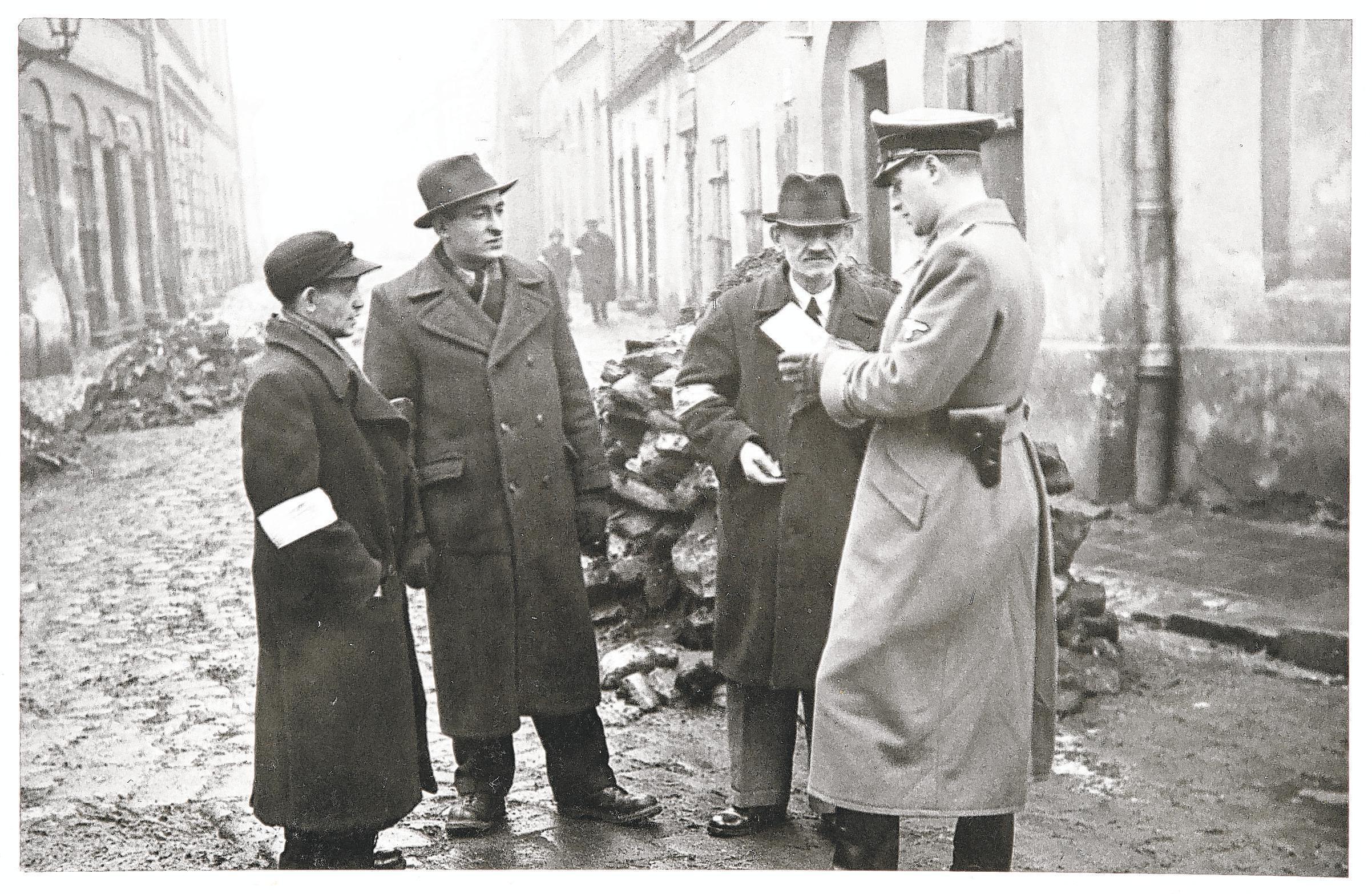
“We all tend to think of the United States as this country with the Statue of Liberty poem — ‘Give me your tired, your poor,’” Holocaust historian Peter Hayes tells us. “But in fact, exclusion of people and shutting them out is as American as apple pie.”
Burns, whose forays into our history have garnered Grammys, Emmys and a cornucopia of other accolades, is a tad more measured in his statement: “Although we accepted more refugees than any other sovereign nation (roughly 225,000), America could have done so much more to help the millions of desperate people
f leeing Nazi persecution.”
Among those who had tried to come here, we are told, was the family of Anne Frank, a teenage girl whose diary about life in hiding became an international bestseller after the war.
“ The Diary of a Young Girl,” with its hopeful optimism and girlish enthusiasm, was published posthumously. Anne, her sister and her mother died in internment camps after their secret apartment in Amsterdam was raided by Nazis. The diary had been rescued by a gentile friend, who gave it to Otto Frank after he was liberated from Auschwitz and returned to the Netherlands to search for his wife and two daughters.
Discovering that the Frank family had tried to flee here “came to our attention when we first started making the film,” says Sarah Botstein, who helped produce and direct the project. “And we thought, Wow.’”
Botstein has worked alongside Burns for 25 years. Past projects include documentaries on the Vietnam War, Prohibition and jazz This time, it was especially personal.
A first-generation American whose father came here from Switzerland as a young child in 1949, Botstein lost several relatives in Nazioccupied Poland. Her grandparents were physicians in Zurich, which is how they survived.
“I grew up with my parents and grandparents who had this history with the experience,” she tells me before adding wistfully, “I wish my grandparents were alive to see the film.”
The genesis of “The U.S. and the Holocaust” goes back to 2015, when Botstein says they heard about a new exhibition being planned by the United States Holocaust Memorial Museum in Washington, D.C., that would examine the pressures shaping American responses to Nazism, war and genocide.
“We thought it was a great subject for a documentary,” she says. They started shooting in 2018.
She declines to give this country a grade on this chapter of its history, though she admits she was appalled to learn that in 1945, when the concentration camps were liberated and newsreel footage graphically revealed their gruesome toll, Americans remained reluctant.
Peter Hayes • Holocaust historianEven after the greatest humanitarian crisis of the Second World War and one of the watershed moments in human history, we did not want to let in refugees,” she says. And that’s pretty devastating.”
Will we watch?
“The U.S. and the Holocaust” arrives against an atmosphere of uncertainty in this country. We are stumbling back from a pandemic, struggling against the specter of a recession and cringing over more elections that threaten to deepen our divisions and dismay. Is this the right time to ask us to spend six hours reliving the Holocaust?
“This is not just a documentary about the Holocaust,” Botstein counters. “This is really about the first part of the 20th century in American history, American politics, American media coverage, American policy.”
She says the team spent a lot of time in the editing room thinking about how much Holocaust history to put into a film about the U.S. response to it.
“America is not responsible for the Holocaust,” she adds. “We were great saviors for democracy and
fighting against fascism in the Second World War. Those are very important things that we want our audiences to understand and come away with.”
It’s a film that raises questions, she says. What did we know? When did we know it? What did we do about it? “And how can we hopefully do better moving forward?”
The teaching won’t end when the televisions are turned off. PBS LearningMedia, the educational arm of PBS, is releasing several free lesson plans for middle and high school classrooms on its website pbslearningmedia.org (check out the Ken Burns in the Classroom hub on the site).
Toward the end of the third and final episode, the words of Eleanor Roosevelt sound a hopeful note about lessons learned.
I have a feeling that we let our consciences guide us too late in standing up to what was wrong,” she lamented. “I hope that in the future, we are going to remember that there can be no compromise at any point with the things that we know are wrong.”
But the final scenes of 21st-century images raise new doubts: a rally for a border wall, White nationalists storming the nation’s capital, the mass murder of 11 worshippers at a Pennsylvania synagogue by a man shouting antisemitic slurs.
The jury, as the saying goes, is still out.
Are we a great land of immigrants, land of refuge, open borders, the more different the better or are we a more isolationist, White supremacist, nativist country?” Botstein asks. It is a question, she adds, “that we’ve been wrestling with since the founding of our nation.”
Dolbee is the former religion and ethics editor of The San Diego Union-Tribune and a former president of Religion News Association. Email: sandidolbeecolumns@gmail.com
‘The U.S. and the Holocaust’
When: 8 p.m. on KPBS-TV (also available to stream on the PBS Video app)
Today: “The Golden Door (Beginnings-1938)”
Tuesday: “Yearning to Breathe Free (1938-1942)”
Wednesday: “The Homeless, The TempestTossed (1942- )”
“We all tend to think of the United States as this country with the Statue of Liberty poem — ‘Give me your tired, your poor,’ But in fact, exclusion of people and shutting them out is as American as apple pie.”
Nepal’s holy river is choked with sewage and trash, to the point where some think nothing less than an act of God can restore its glory
BY BINAJ GURUBACHARYA K ATHMANDU, NEPALHigh on a mountain in the Himalayas, pristine drops fall from the mouth of a tiger statue installed at a stream thought to form the headwaters of the Bagmati River, long revered as having the power to purify souls. From there it wends its way downhill past verdant forests and merges with other waterways, irrigating fields of rice, vegetables and other crops that are a livelihood for many Nepalese.
But as the Bagmati reaches the valley of Kathmandu, the capital, its color changes from clear to brown and then to black, choked with debris, its contents undrinkable and unsuitable even for cleaning. During the dry season, an overwhelming stench pervades the area by its banks.
Tainted by garbage and raw sewage that is dumped directly into the waterway, Nepal’s holiest river has deteriorated so greatly that today it is also the country’s most polluted, dramatically altering how the city of about 3 million interacts with the Bagmati on daily, cultural and spiritual levels.
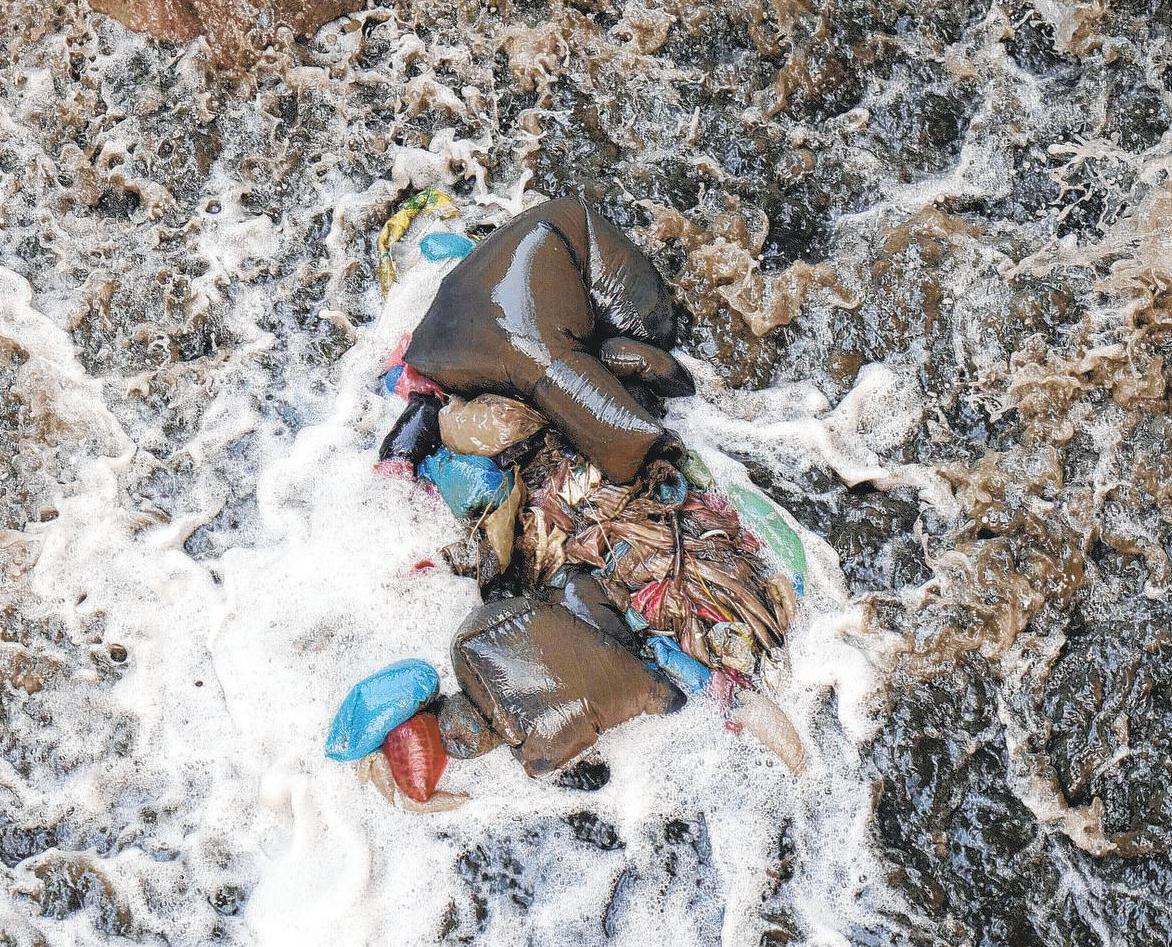

In the capital, the Bagmati’s sludge oozes past several sacred sites, including the Pashupatinath Temple, declared a World Heritage Site by UNESCO in 1979.
The sprawling complex comprises a golden-roofed main temple dedicated to the Hindu god Shiva, surrounded by hundreds of smaller ones.
Hindus flock to the riverbanks in Kathmandu to worship at shrines and celebrate festivals.
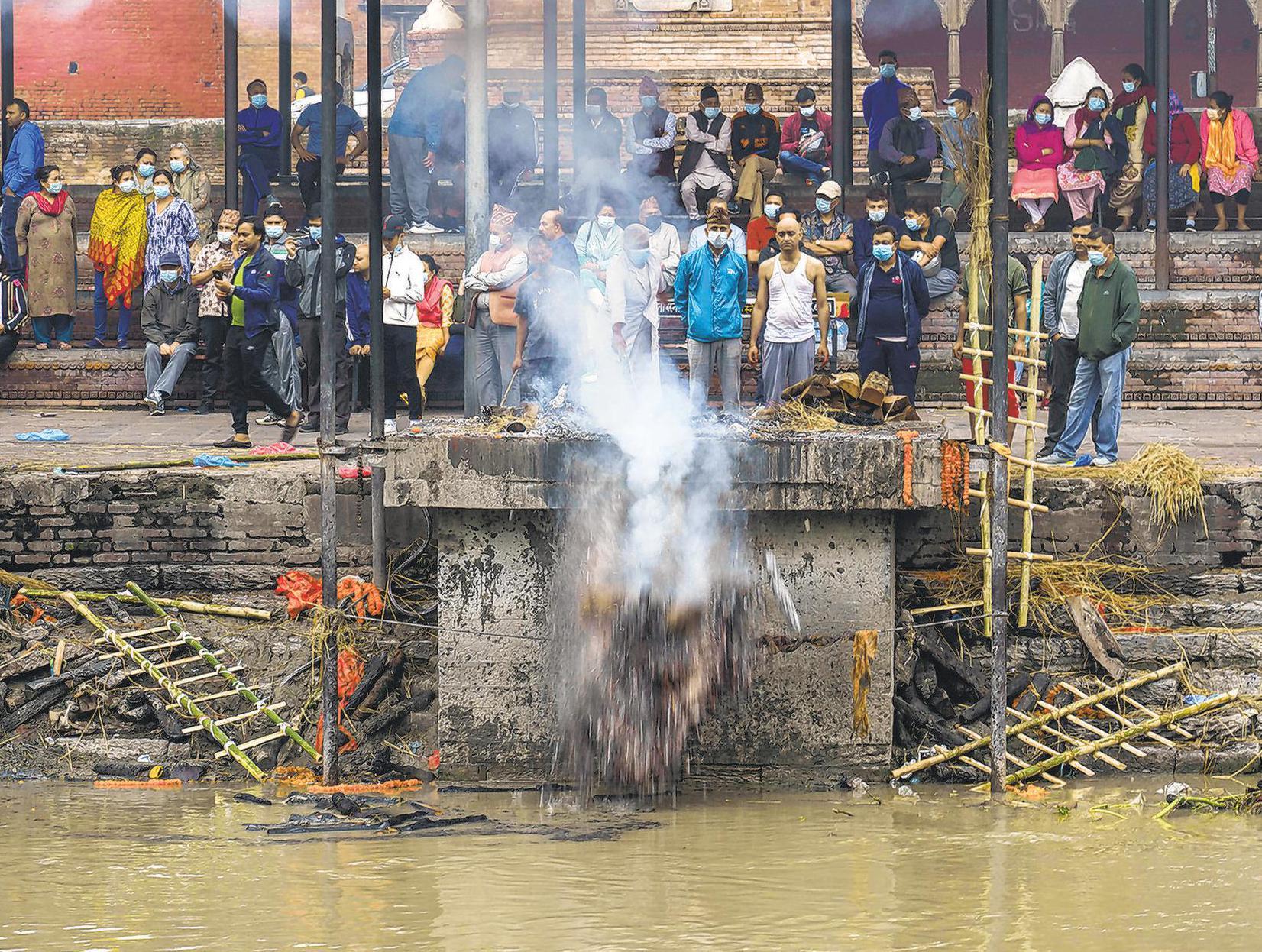
Women dip in the river to wash away sins during Rishi Panchami, a day for worship of the seven sages revered as enlightened beings guiding humanity through the ages. Visitors also wade in during the festival of Chhath, praying to the sun god Surya. During Teej, married women come to pray for the health and prosperity of their husbands, and single women pray to find a good one.
Families have long carried the bodies of deceased loved ones to these banks to wash the feet of the dead on a stone slab and sprinkle their faces with river water. Beliefs hold that this washes away a

As San Diego’s college students pursue their education amid lingering COVID-19 concerns, the chaplains and campus ministers who care for them say the pandemic’s challenges remain.
In fact, they say, the pandemic has worsened students’ already pronounced economic, social, academic and mental health stressors, deepening their need for spiritual g uidance.
A recent study commissioned by the InterVarsity Christian Fellowship, reported in Christianity Today, indicates that the pandemic will continue to shape how university communities gather and will have ongoing effects on students’ mental health and social lives.
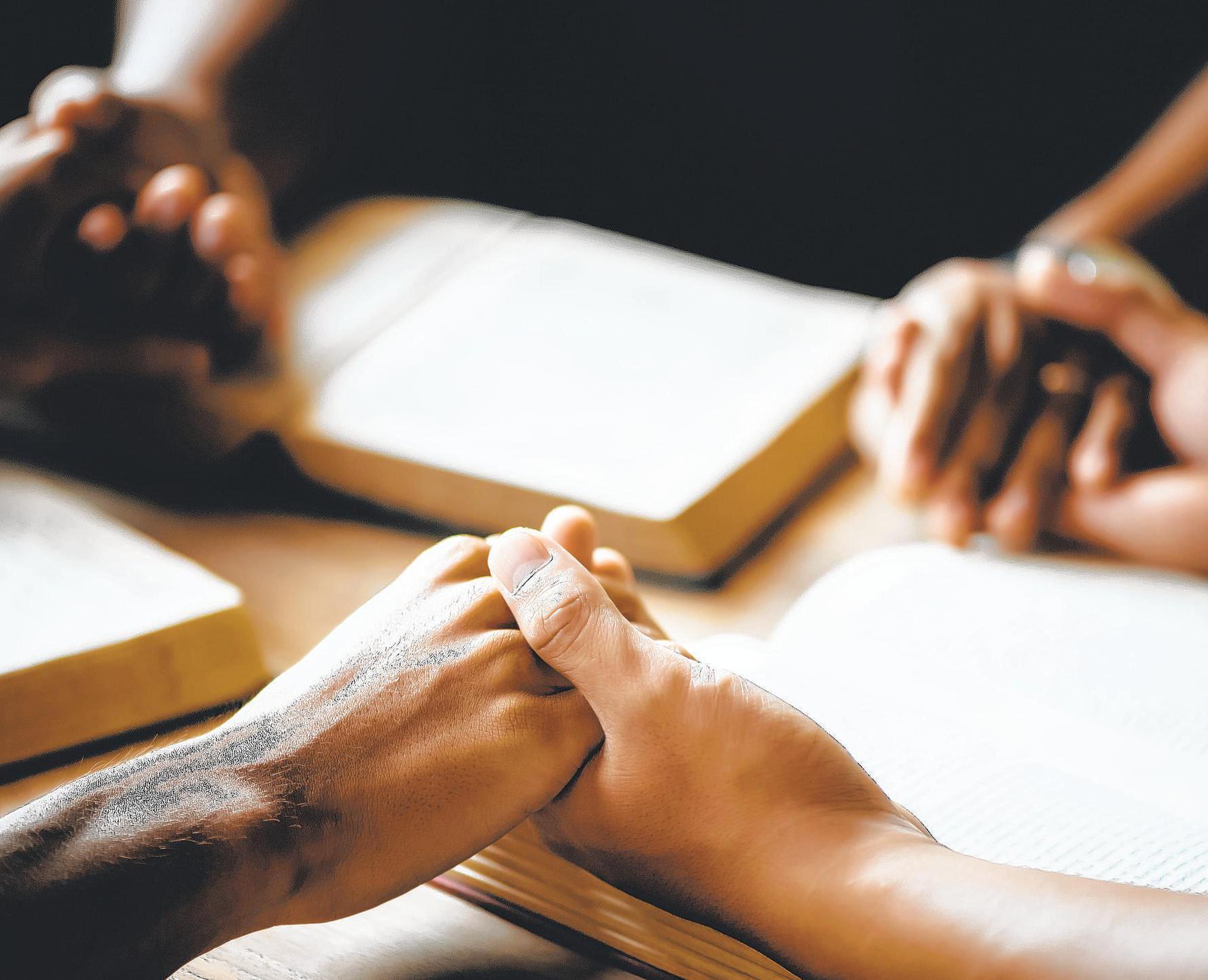
The study is one of several confirming that college students suffer higher levels of pandemicinduced stress and anxiety as they experience isolation and loneliness.
San Diego State University lost two Jewish students to suicide during the pandemic, says Chabad House’s Rabbi Chalom Boudjnah, who has worked on the campus for 23 years. The deaths, he says, were stark indicators of students’ increased need for spiritual support.
“A lot of students come to university and find it a very confusing and emotionally difficult environment,” Boudjnah explains.
In high school, they were with all their friends and social groups, and now they are completely on their own, starting from scratch. It’s then they must have cultural, emotional and spiritual help in navigating college.”
He now believes that one of the most important roles of campus spiritual advisers is to support students’ mental health.
At the University of San Diego, the University of California San Diego and San Diego State University, campus chaplains and spiritual ministers work closely with universities’ academic and mental health counselors. That team approach plays an ever more important role in students’ wellbeing in COVID-19’s wake, says USD’s Michael Lovette-Colyer.
“ There’s always been a connection and an important overlap between mental health and spiritual issues,” says Lovette-Colyer, USD’s vice president for mission integration. “The last three years have been hard, and we’ve indicated to students that it’s OK for them to share about their mental health challenges and ask for help in navigating those challenges.”
USD’s 10-member team of chaplains and lay ministers are redoubling their efforts, he says, discovering new and creative ways to reach out to students.
person’s sins and sends their soul to heaven before their physical remains are cremated atop heaps of wood, also alongside the river, and their ashes scattered into the waters.
People still bring departed loved ones to the Bagmati, but many no longer dare to have any contact with its contents. While the bodies are still cremated here, they’re cleansed with purified water bought in nearby stores.
“ That is no more now. The water is so dirty and stinks. People are forced to bring bottled water and do the rituals,” 59-year-old Mithu Lama, who has been working with her husband at the Teku ghat cremation grounds since she married him at age 15, said on a recent day as she stacked wood for a funeral pyre.
Grieving families who resort to bottled water typically are loath to discuss it openly, for having failed to follow the sacred funeral tradition.
‘People are the problem’
People have also traditionally collected river water to sprinkle on their homes to purify them. The river is significant to Buddhists, too, many of whom cremate bodies on the Bagmati’s banks.
Born and raised next to the Bagmati, Lama recalled using its waters for cooking, bathing, washing and even drinking. Today that feels like a long-ago dream dashed by decades of dumping human waste and refuse, and one she doesn’t expect to see again anytime soon.
I now have serious doubt that it will be cleaned in my lifetime,” Lama said. “Not that there has not been any
takeout kosher chicken soup that students order for themselves or others.
Before COVID-19, Boudjnah recalls, hundreds of students participated in Jewish Life dinners every Friday night. But those days were gone, so he and his wife encouraged students picking up their soup to stay and socialize at a safe distance.
“We made the to-go packages for 50 to 100 students, and people would stay and chat outdoors,” he says. When it was safe, Chabad hosted small outdoor events, including arts-and-craft activities.
“We felt we couldn’t give up on our students. It was important for them to feel they’re not alone. That’s part of being a rabbi, friend and mentor — someone who cares and loves you no matter what.”
The role of campus ministers and chaplains has changed over time just as the needs of young people have changed, USD’s Lovette-Colyer says.
GETTY IMAGES“As we become aware of these challenges, we are trying to respond to meet their needs, and we’re still figuring it out.”
SDSU’s John Gillman, emeritus lecturer in the Department for the Study of Religion and currently at the Franciscan School of Theology, taught a variety of classes in his 34 years on campus. Some of his last courses focused on death, dying and the afterlife. Teaching via Zoom during the pandemic, Gillman says he had a number of students with family members and friends who tested positive and even died from COVID.
It was surprising that some students’ earliest and most recent death experiences would be the death of a classmate or family
member, acquaintance, or friend from COVID (during the duration of the class),” he says.
He and his students also experienced the recent death of a student in one of his classes.
“He was a gregarious, outgoing person,” Gillman recalls. “A number of students in the class knew him well, and there was a heavy sense of grief and loss when we met after his death.”
Campus ministers who can relate to and connect with students in nonjudgmental ways and are in tune with students both socially and spiritually are important at both secular and religious institutions, Gillman says.
“Support from campus ministers is instrumental in providing a safe space for students to talk
about their stressors, losses, spiritual issues and their search for meaning in a chaotic time,” he says. “They can provide a listening ear and accompany students through hardship.”
Boudjnah says he realized early on that livestreaming events wasn’t effective in maintaining close contact with students.
The pandemic was very, very hard,” he says. “The hardest part was losing face-to-face connection.”
That prompted he and his wife, Mairav — who have eight children of their own — to create new ways for Chabad to reach out to isolated students. One of last semester’s efforts was working with student volunteers to make
In another generation, young people strongly identified with religious traditions,” he notes. You can’t take those things for granted anymore. So chaplains must be proactive, finding ways to work with colleagues across campus to amplify our efforts.”
Boudjnah believes that more chaplains, rabbis and ministers are needed on university and college campuses, and that their roles are expanding.
Especially after the pandemic and with inflation, things are hard for students,” he says. “We need people who want to do this kind of work.”
Students need to know that they are special, they are not alone, and that they have a mission, no matter how dark the world seems, he adds.
“We must empower people to believe in themselves and the greater good. We must be positive and be there for students all the time — no matter what.”
For his part, Lovette-Colyer is hopeful for the future. While students may not relate to organized religions in large numbers, they nevertheless show more interest in spirituality, while campus ministers become more cognizant of students’ mental health.
“Spirituality is part of the learning experience,” he says. “It’s absolutely essential that there be serious consideration of faith and spirituality among college students, with different faith traditions and perspectives.
“During college, one is ideally asking themselves questions about who they are, what they want out of life, preparing for their career and so much more,” he adds. “No one goes to college to stay the same. If nothing else, we want to cultivate our interior life as much as possible.
“Spirituality in college is more important now than ever. Our world is complex and challenging, and students must learn how best to prepare themselves to live purposefully in that world.”
Douglas is a freelance writer.efforts — there have been several cleaning campaigns but there are more people dirtying it. People are the problem.”
Indeed, there have been efforts by private volunteers and the government to clean up the river. Among those initiatives, every Saturday for the past seven years hundreds of volunteers have gathered in Kathmandu to pick up garbage and remove trash from the Bagmati.
There almost every weekend is Mala Kharel, an executive member of the governmental High Powered Committee for Integrated Development of the Bagmati Civilization, which was set up to help clean up the river. She volunteers her time not only for cleanup duty but to raise awareness among the population about avoiding pollution.
Kharel said that over the years the campaign has succeeded in collecting about 80 percent of garbage
along the riverbank, recovering all sorts of refuse from decaying animals to even, shockingly, the bodies of dead babies dumped there. But the pickup efforts admittedly fall short of perfection, in part because frequent disruptions to trash collection services encourage more dumping than they can keep up with.
In addition, many thousands of people have built huts, shacks and brick homes illegally along the river and refuse to leave.
As for the sewage, according to Kharel, the committee is working on several projects including the construction of canals and pipes, built parallel to the river, to connect to sewer lines and prevent waste from reaching the Bagmati.

It also is considering a treatment plant, and working on upstream dams where rainwater can be captured and stored during the monsoon season and released
during the dry months to f lush the river, moving the waste downstream from Kathmandu.
Work on the pipe and canal system began around 2013, but no completion date has been announced. Construction on two dams is ongoing — but said to be near done — while another remains in the process of getting started. But campaigners have high hopes for the near term.
“In the next 10 years, I am hoping the river will be f lowing clear and the banks will be clean and lined with trees,” Kharel said. “We are working hard with this target.”
That optimism isn’t shared by everyone. Some environmentalists aren’t sure the dams, for instance, will be of much help.
There is too much expectations from these dams. Bagmati is a natural
river and not a canal that can be cleaned so easily,” said Madhukar Upadhya, a watershed expert who studies the river closely and said its bed no longer has any sand left.
Instead, today it’s lined with clay and mixed with chemicals dumped by industrial activity such as handwoven carpet makers, popular in the 1990s but now banned from the capital.
So much damage has already been done to it,” Upadhya said, “that it can perhaps be cleaned to some degree but not restored to its past glory.”
Hindu priest Pandit Shivahari Subedi, who has spent three decades on the stone steps between the Bagmati and the Pashupatinath Temple performing rituals for devotees, takes a similarly dim view of the various cleanup campaigns he has seen. Divine intervention, he believes, is needed.
“ There have been too
Around the world, over millennia, rivers have provided wondrous gifts — nourishment, mobility, irrigation, natural beauty. In acknowledgment of those gifts, some cultures consider the rivers of their realms to be sacred — beseeching them with prayers, partaking of their waters for joyous and somber rituals. Today, even as these rivers remain an object of devotion, some face dire threats — severe pollution, diminution of their flow, hydroelectric projects. In Nepal, many devout Hindus no longer cleanse the bodies of their newly deceased loved ones with the waters of the Bagmati River — it’s befouled by sewage. In the Middle East, the Jordan River’s dwindling waters are a dull greenish brown as they approach the site revered as where Jesus was baptized.
The Associated Press’ Religion Team has launched a six-part series about the Bagmati, the Jordan and four other sacred rivers. The stories will run in the Union-Tribune in the coming months. This is Part 3.
many assurances from political leaders and top people, but they have all not been fulfilled. ... It looks like unless the gods create some kind of miracle, the Bagmati will not return to its glory,” Subedi said. “To clean the water naturally, by the grace of God, there needs to be huge flooding of water flushing the dirt.”
Associated Press religion coverage receives support through the AP’s collaboration with The Conversation US, with funding from Lilly Endowment Inc. The AP is solely responsible for this content.
The WhatsApp message arrived on May 10. “I got my call sign,” was all it read, signed Strike.” And in the weeks that followed, leading up to the release of “Top Gun: Maverick” and after it finally opened, every message from my dad was also signed Strike.
He was hardly alone in his excitement. This has been a summer of dads — and daughters and mothers and brothers and sons but mostly dads, who can’t get enough of the new Top Gun,” starring Tom Cruise.
The classically styled Hollywood tale of a sidelined Navy fighter pilot nearing retirement brought back for one final flight and a shot at redemption has now passed $700 million at the North American box office. It’s Cruise’s highestgrossing film ever.
But the director, Joseph Kosinski, never anticipated it would be so popular. Kosinski, whose credits include “Tron: Legacy” (2010) and “Spiderhead” earlier this year, has mostly worked on movies with lots of special effects and on smaller projects. Still, he had loved the 1986 “Top Gun,” and it was some of that movie’s sepia-toned spirit that he wanted to capture in the sequel.
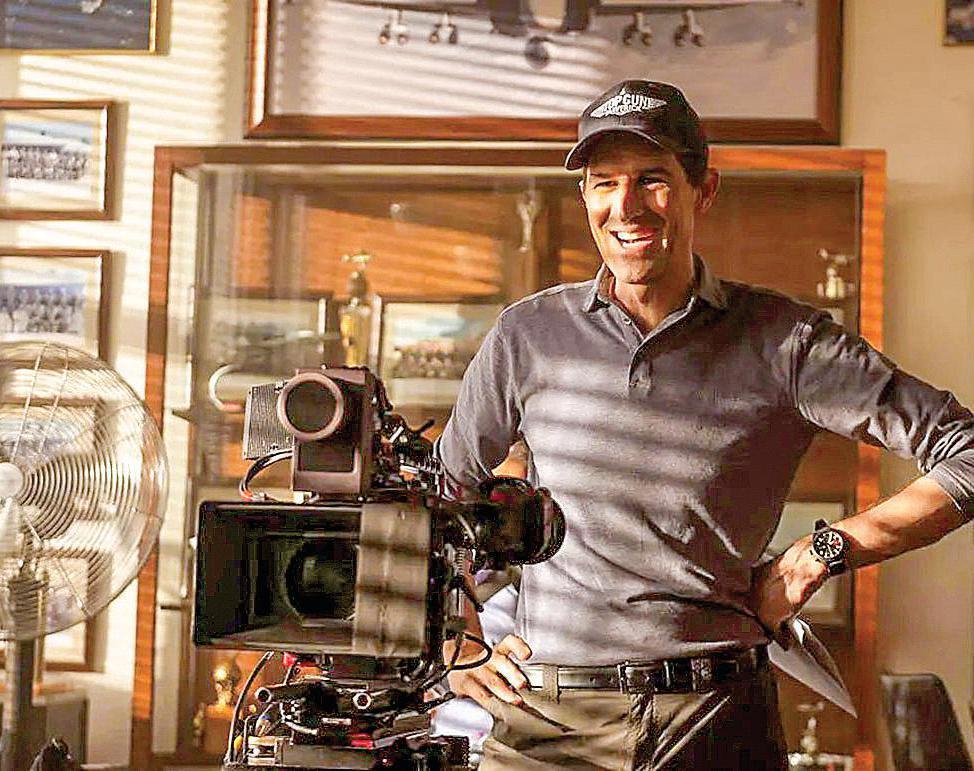
From his home in Santa Monica, he spoke via video about what it’s been like being behind the biggest movie of 2022. These are edited excerpts from our conversation.
Q: I have seen “Top Gun: Maverick” multiple times. And I’m not the only one. Why do you think it resonated so much this summer?
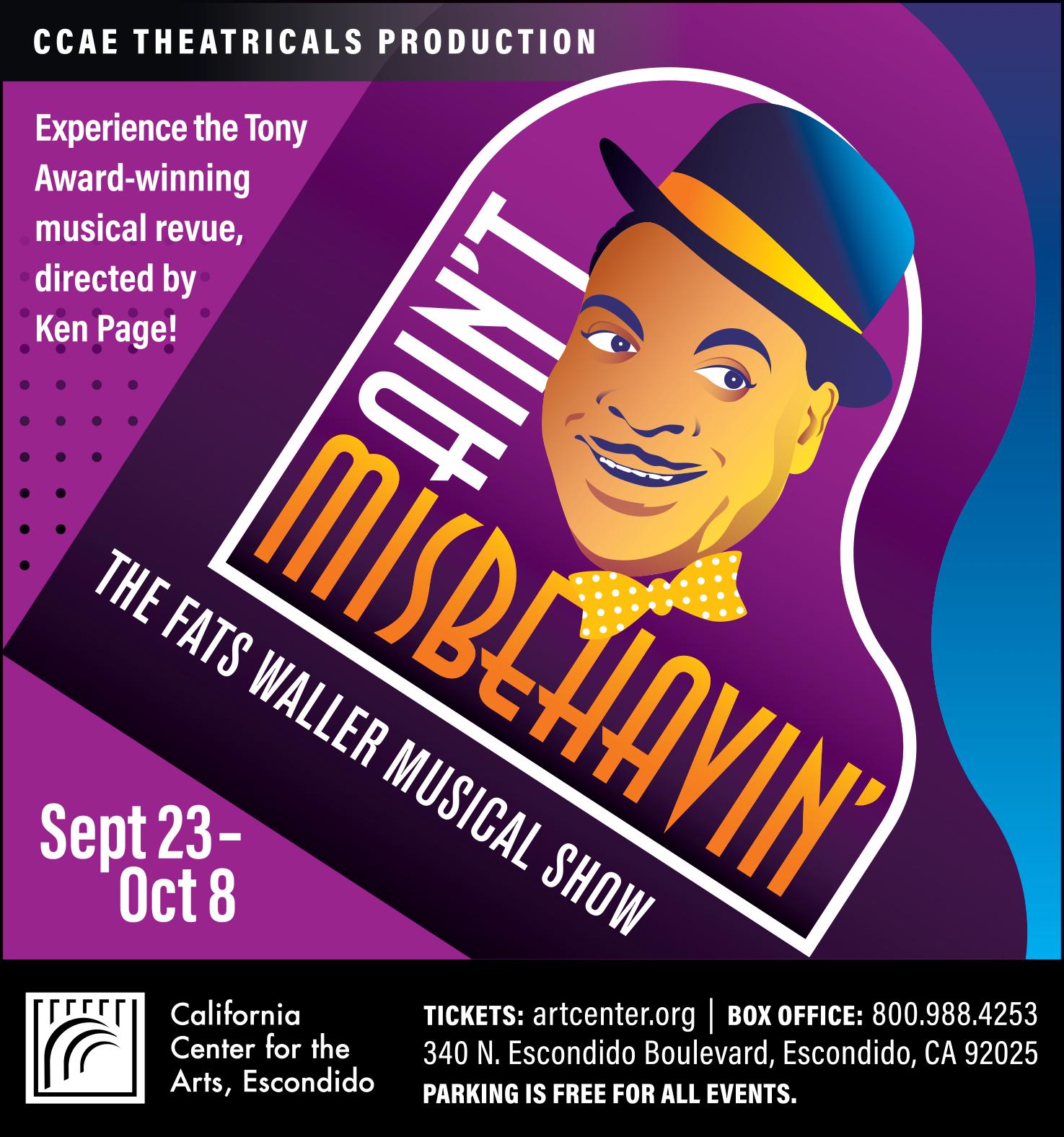
A: I definitely had my experience of seeing the first when I was 12 in the back of my head. I was aspiring to create that big summer movie experience and a movie that had to be seen on the big screen.
I also wanted to capture the experience of what it’s like to be in one of these airplanes. I think people who have been used to movies where the spectacle comes from CGI imagery — I’ve done those movies — (wanted) to see and feel something real in a movie. I have a lot of people come up to me and say, “I was gripping the edge of my seat for the last 40 minutes.”
More important than that, when I asked people why you went three times, people like you, it’s not f lying they talk about. They say I go back for the emotional experience of it. I think it’s because the themes of the film are very universal. It’s family, friendship, sacrifice, regret, mortality, things we all deal with.
A:It’s very complicated because it is like three-dimensional chess. Before my meeting with Tom, I saw online that some Navy pilots were putting on YouTube these videos where they would film their training exercises by putting a little GoPro on the canopy next to them. And so there was this kind of off-kilter angle that was capturing their training f light, and when I saw that, I was like, this is more interesting than any aerial sequence I’ve seen in a movie in a long time. So, (I wanted to) get the choreography of dog fighting, and do it in a two-seat airplane so Tom can be in the back and the (actual) Top Gun pilot can be in the front and (a real) Top Gun pilot is in the same thing that Tom’s wearing.
Then, I can shoot Tom with these cameras, and it’ll look like Tom’s flying it. That was the inspiration. Then we went to Top Gun, and we worked with the best pilots in the world flying these sequences for us.
Q:What about the original did you love, and what did you want to do differently with this one?
A:Tony Scott created this world on the screen that was like a fantasy world. It’s always magic hour. And he has an affair with his teacher, right? It’s a bit of a boyhood fantasy. There’s a timelessness to “ Top Gun,” and I wanted this movie to feel the same: It is a contemporary story but there’s very little that actually sets it in 2022. If you look close, the only kind of modern device is Mav’s cellphone, which isn’t even that modern. Everything else, from his plane, to (his g irlfriend) Penny’s car, is pulled from different eras.
We approached every day trying to figure out how can we shoot the scene we need to shoot at 5:30 p.m. to get that light. I grew up in Marshalltown, Iowa, and
maybe that’s why I was, hopefully, the right guy to do it: I was coming as a person who hadn’t grown up in California and got to re-create the perfect version of it.
Q: What was it like to work with Tom Cruise and Val Kilmer?
A: This is my second movie with Tom (after “Oblivion,” from 2013), so I knew a little bit what I was in for, and it’s everything you hear. It’s fully committed to the project, invested in every aspect of it, and inspiring to watch. Val Kilmer, someone I always looked up to, and to be able to bring him back in one of his most iconic roles, and the scene with him and Tom was one of those experiences I’ll never forget. Just two guys at the top of their game playing a scene that I think was very genuine.
Q: I know it’s vague, but who is the enemy in “ Top Gun” supposed to be?
A: We had that great g uidance from the f irst movie — it’s this faceless, nameless bad guy, which is perfect because, again, we didn’t want to make a movie about politics. You can’t really connect it to any real-world enemies. The mirrored, masked pilots also contribute to this feeling of this being a little bit in an alternate reality. That was a fun exercise as a director, to create a nontraceable enemy.
Q: How do you feel about being called the savior of Dad Cinema?
A: Being a dad with three kids, I take that as a compliment. I made a movie about firefighters (“Only the Brave”), which is also known to bring grown men to tears. I’ll wear that badge with pride. To see young kids have a great experience, but also to have an experience with their dad and their grandpa or
grandma, that, to me, is the most gratifying thing.
Q: You also had a hit this summer with Netflix’s “Spiderhead.” What was it like having these two films out at the same time?

A: It was five years of work compressed into two movies released three weeks apart. That was unique and will never happen again, I hope. “Spiderhead” was a completely different tone, shot in the middle of the pandemic — a very inward-looking, threecharacter almost stage play. So from a creative point of view, it was a wonderful experience to be able to make both of those movies. But yeah, from a releasing point of view, it was a lot. Bloom writes for The New York Times.
Today: Actor Robert Blake is 89.
Gospel singer Bobby Jones is 84.
Singer-actor Frankie Avalon is 82.
Actor Anna Deavere Smith (“The West Wing”) is 72. Singer Joanne Catherall of Human League is 60.
Singer Ricky Bell (Bell Biv Devoe, New Edition) is 55. Actor and talk show host Aisha Tyler is 52. Actor Jada Pinkett Smith is 51. Actor James Marsden (“The Notebook,” “Ally McBeal”) is 49. Actor Emily Rutherfurd (“The New Adventures of Old Christine”) is 48. Actor Travis Schuldt (“Scrubs”) is 48. Rapper Xzibit is 48. Comedian Jason Sudeikis (“Ted Lasso,” “Saturday Night Live”) is 47. Actor Sophina Brown (“Numb3rs”) is 46. Actor Barrett Foa (“NCIS: Los Angeles”) is 45. TV personality Sara Haines (“GMA3: Strahan, Sara and Keke,” “The View”) is 45. Actor-comedian Billy Eichner is 44. Actors Taylor and Brandon Porter (“Party of Five”) are 29. Actor Patrick Schwarzenegger (“Midnight Sun”) is 29. Country singer Tae Kerr of Maddie and Tae is 27.
Monday: Actor Rosemary Harris is 95. Actor David McCallum (“The Man From U.N.C.L.E.” and “NCIS”) is 89.
Singer Bill Medley of the Righteous Brothers is 82. Singer-songwriter Paul Williams is 82. Singer Freda Payne is 80. Singer David Bromberg is 77. Actor Randolph Mantooth (“Emergency”) is 77. Actor Jeremy Irons is 74. TV personality Joan Lunden is 72. Actor Carolyn McCormick (“Law and Order: Special Victims Unit”) is 63. TV chef Mario Batali is 62. Comedian Cheri Oteri (“Saturday Night Live”) is 60.
Country singer Jeff Bates is 59.
Country singer Trisha Yearwood is 58. News anchor Soledad O’Brien is 56.
TV chef Michael Symon is 53. Actor Victor Williams (“The Affair,” “King of Queens”) is 52. Comedian-talk show host Jimmy Fallon is 48. Homeimprovement host Carter Oosterhouse (“Red Hot and Green,” “Trading Spaces”) is 46. Singers Tegan and Sara Quin of Tegan and Sara are 42.
Actor Danielle Panabaker (TV’s “The Flash”) is 35. Actor Katrina Bowden (“The Bold and the Beautiful,” “30 Rock”) is 34.
Tuesday:Actor Sophia Loren is 88.
Actor Tony Denison (“Major Crimes,” “The Closer”) is 73. Actor Debbi Morgan (“Power”) is 71. Actor Gary Cole is 66. Actor Kristen Johnston (“3rd Rock From the Sun”) is 55.
Actor Enuka Okuma (“Rookie Blue”) is 50. Actor Moon Bloodgood (“Falling Skies”) is 47. Actor Jon Bernthal (“The Walking Dead,” “Daredevil”) is 46. Singer The-Dream is 45. Actor Charlie Weber (“How to Get Away With Murder”) is 44. Actor Crystle Stewart (“For Better or Worse”) is 43. Rapper Yung Joc is 42.
Actor Aldis Hodge (“Straight Outta Compton,” “Hidden Figures”) is 36.
Actor Malachi Kirby (2016’s “Roots”) is 33.
Wednesday: Author-comedian Fanny Flagg is 81. TV and film producer Jerry Bruckheimer is 79. Guitarist Don Felder (The Eagles) is 75. Author Stephen King is 75. Actor Bill Murray is 72. Filmmaker Ethan Coen is 65.
Actor-comedian Dave Coulier (“Full
House”) is 63. Actor Serena Scott Thomas is 61. Actor Angus Macfadyen (“Braveheart”) is 59. Actor Cheryl Hines (“Curb Your Enthusiasm”) is 57. Country singer Faith Hill is 55. Actor and talk show host Ricki Lake is 54. Rapper Dave of De La Soul is 54. Actor Billy Porter (“Pose”) is 53. Actor Alfonso Ribeiro (“America’s Funniest Home Videos,” “The Fresh Prince of Bel-Air”) is 51. Actor Luke Wilson is 51. Actor Paulo Costanzo (“Royal Pains,” “Joey”) is 44. TV personality Nicole Richie (“The Simple Life”) is 41. Actor Maggie Grace (“Lost”) is 39. Actor Joseph Mazzello (“Simon Birch”) is 39. Actor Ahna O’Reilly (“The Help”) is 38. Rapper Wale is 38. Singer Jason Derulo is 36. Actor Ryan Guzman (“Heroes Reborn,” “Pretty Little Liars”) is 35. Actors Nikolas Brino (“7th Heaven”) is 24.
Thursday: Singer-dancer Toni Basil is 79. Actor Paul Le Mat (“American Graffiti”) is 77. Singer David Coverdale (Whitesnake, Deep Purple) is 71. Actor Shari Belafonte is 68. Singer Debby Boone is 66. Singer Nick Cave is 65. Actor Lynn Herring (“General Hospital”) is 65. Singer Joan Jett is 64. Opera singer Andrea Bocelli is 64. Actor Scott Baio is 62.
Actor Catherine Oxenberg (“Dynasty”) is 61. Actor Bonnie Hunt is 61. Actor Rob Stone (“Mr. Belvedere”) is 60. Rapper Mystikal is 52. Actor James Hillier (“The Crown”) is 49.
Actor Mireille Enos (“World War Z”) is 47. Actor Daniella Alonso (“Revolution,” “Friday Night Lights”) is 44.
Actor Michael Graziadei (“The Young and the Restless”) is 43. Actor Katie Lowes (“Scandal”) is 40. Actor Tatiana Maslany (“She-Hulk: Attorney at Law,” “Orphan Black”) is 37. Actor Ukweli Roach (“Blindspot”) is 36.
Actor Tom Felton (“Harry Potter” films) is 35. Actor Teyonah Parris (“Mad Men”) is 35.
Friday: Singer Julio Iglesias is 79.
Actor Paul Petersen (“The Donna Reed Show”) is 77. Actor-singer Mary Kay Place is 75. Singer Bruce Springsteen is 73. Director George C. Wolfe (film’s “Nights in Rodanthe,” stage’s “Angels in America”) is 68.
Actor Rosalind Chao (“Star Trek: Deep Space Nine,” “M*A*S*H”) is 65.
Actor Jason Alexander (“Seinfeld”) is 63. Actor Chi McBride (“Hawaii Five-0,” “Boston Public”) is 61. Singer Ani DiFranco is 52. Rapper-producerrecord head Jermaine Dupri is 50.
Actor Kip Pardue (“The Rules of Attraction,” “Remember the Titans”) is 46. Actor Anthony Mackie (“Abraham Lincoln: Vampire Hunter”) is 44.
Actor Brandon Victor Dixon (“Hamilton”) is 41. Actor Cush Jumbo (“The Good Fight,” “The Good Wife”) is 37. Actor Skylar Astin (“Pitch Perfect” films) is 35.
Saturday: News anchor Lou Dobbs is 77. Actor Gordon Clapp (“NYPD Blue”) is 74. Actor Harriet Walter (“The Crown”) is 72. Actor Kevin Sorbo (“Hercules: Legendary Journeys”) is 64. Actor-writer Nia Vardalos (“My Big Fat Greek Wedding”) is 60. Actor Ian Bohen (“Yellowstone,” TV’s “Teen Wolf”) is 46. Actor Spencer Treat Clark (“Animal Kingdom”) is 35. Actor Grey Damon (“Station 19”) is 35. Actor Kyle Sullivan (“Malcolm in the Middle”) is 34. Actor Ben Platt is 29.
Q: Can you talk just a bit more about the f light scenes?Director of the year’s biggest movie talks Dad Cinema and how they shot those dogfights Joseph Kosinski was a big fan of the sepia-toned “Top Gun,” released in 1986, and wanted to re-create that vibe in the sequel. “Tony Scott created this world on the screen that was like a fantasy world. It’s always magic hour.” SCOTT GARFIELD PARAMOUNT PICTURES
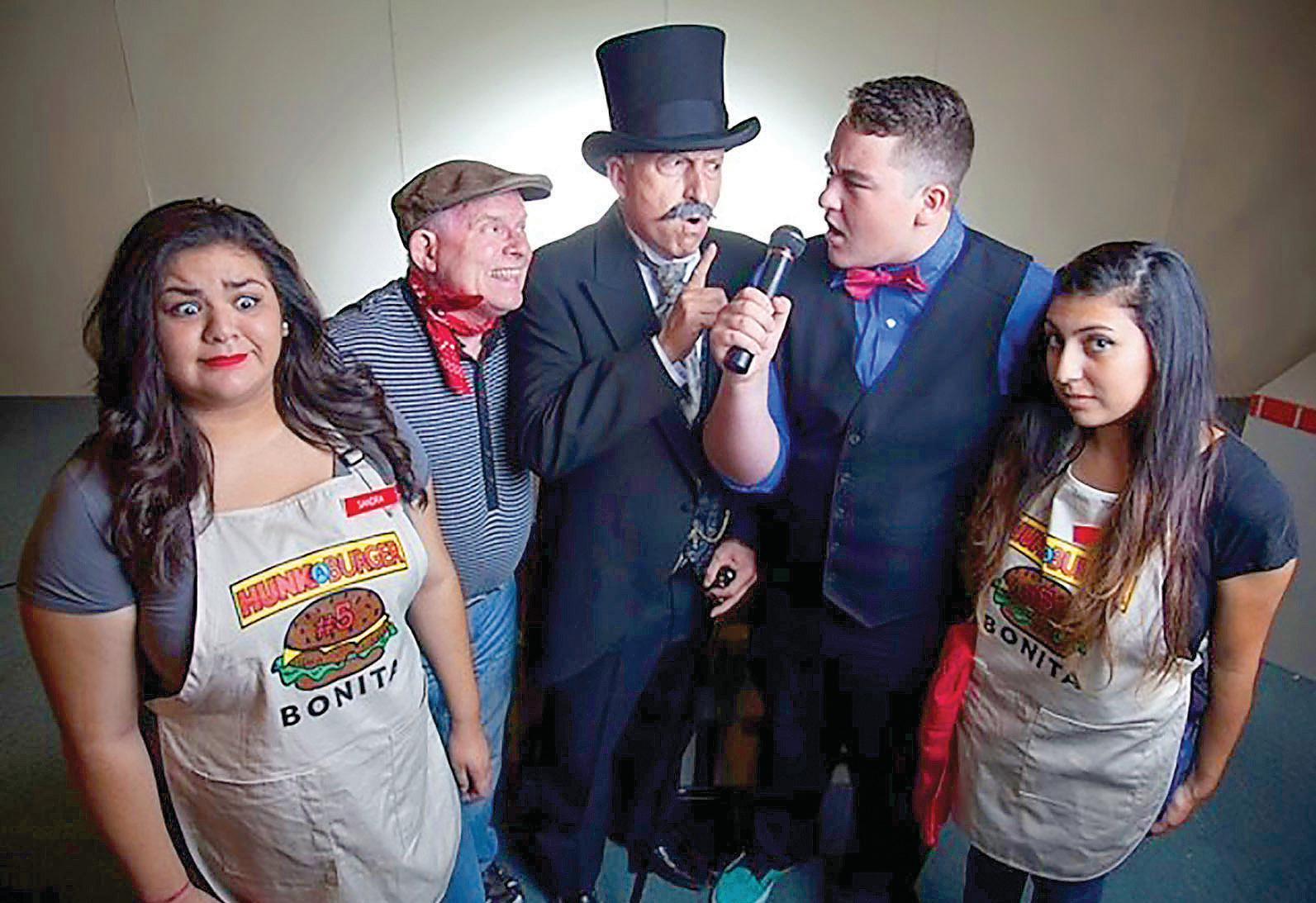 BY PAM KRAGEN
BY PAM KRAGEN
For 45 years, Max Branscomb has been writing and directing the annual Bonitafest Melodrama.
Branscomb said the audience-interactive melodrama project about real San Diego County history is the longestrunning uninterrupted theatrical project in San Diego County. The shows blend true stories from San Diego history with 1880s Western melodrama motifs and contemporary American musical theater. The audience is encouraged to cheer, boo, hiss and more.
This year’s melodrama, “Really Fast Food,” will be presented at 7:30 p.m. Sept. 21-24 at Sweetwater Community Church Theater, 5305 Sweetwater Road, Bonita. The plot is based on a “mystery meat” scandal at a South County food chain in the 1980s, where kangaroo was included with Australian beef in some shipments.
What it is really about, though, is that magical and scary last summer when high school graduates prepare to go off to college,” said Branscomb, a journalism professor at Southwestern College in Chula Vista. “I have always felt that too many adults are cynical and sometimes mean to teenagers, and fail to see them as potentially great, amazing people.”
The Bonitafest Melodrama was founded in 1978 by Corky Mizer (the owner of Corky’s Pest Control) and Glennalie Coleman. They recruited Branscomb, then a 20-year-old journalist, to write the script, which he drew from local history. The Bonitafest Melodrama has been honored by arts and civil rights organizations for its inclusivity, and by state and county government for its contributions to San Diego culture and heritage.
Branscomb said scores of melodrama alumni have gone on to careers in the performing arts and arts education, including Bianca Quilantan, who was named a finalist for the 2019 Pulitzer Prize for Breaking News for her 2018 coverage of the Camp fire while still a student at Chico State University. She is now an education reporter for Politico in Washington, D.C.
To keep the annual tradition alive during the COVID-19 pandemic, Branscomb produced the melodrama last year as a radio production, just as he did his other well-known holiday theater project, “La Pastorela.” Both shows aired last year on local radio stations.
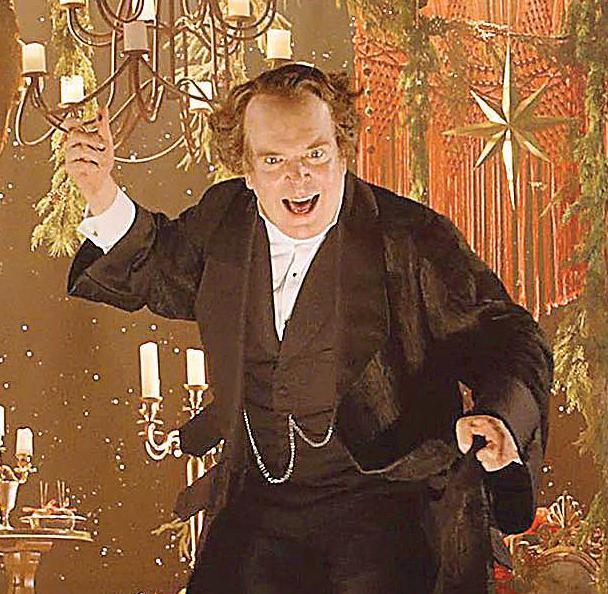
Ticket prices for the Bonitafest Melodrama are $12 for adults. Children 12 and under pay a dollar for each year of their age. The show’s opening-night performance will have a pre-show catered Mexican dinner. A ticket for dinner and show on opening night is $20.
For tickets, call (619) 850-7126. Visit facebook.com/bonitafest melodrama
Two musicals born at the Old Globe in recent years, “Almost
Famous” and “Allegiance,”
Almost
Featuring a book and lyrics by Crowe, score by Tom Kitt and direction by Jeremy Herrin, the rock ’n’ roll coming-of-age musical made its world premiere at the Globe in 2019. Most of the cast members featured at the Globe are reprising their performances on Broadway.

Meanwhile, “Allegiance,” the Old Globe-born Broadway musical about Japanese Americans interned during World War II, will make its United Kingdom premiere in January, with a 15-week engagement in a small off-West End theater in London. Two of the show’s original Globe and Broadway stars, George Takei and Telly Leung, will appear in the production.
The musical by Marc Acito, Jay Kuo and Lorenzo Thione premiered at the Globe in 2012 and opened on Broadway three years later. Producers say the musical has been “reconceived” for its London run.
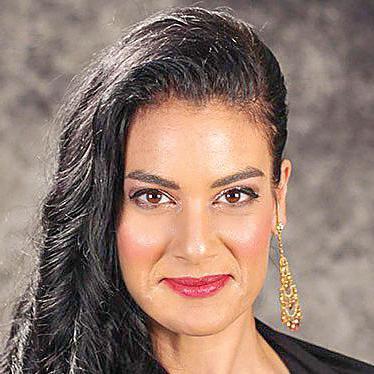 BY BETH WOOD
BY BETH WOOD
Victoria Mature spent her teenage years, as many of us do, playing music that drove her parents a little crazy. Her father, Victor, the late hunky movie star of the 1940s and ’50s, would plead for something upbeat while her mother, Lorey, would say, “Not that again!”
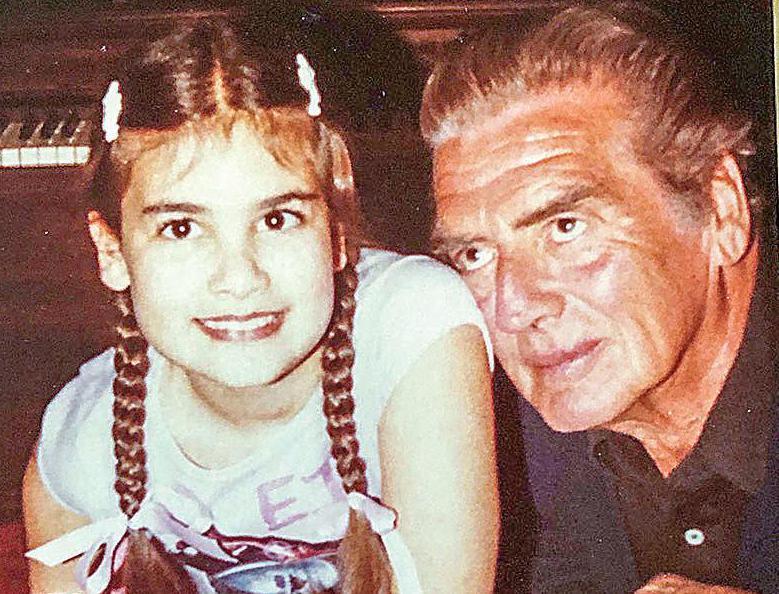
But it wasn’t Nirvana or Snoop Dogg who were the objects of their annoyance. Victoria had fallen for Henry Purcell, the 17th-century creator of the first known Englishlanguage opera, “Dido and Aeneas.”
“I would sing ‘Remember me, when I am laid in earth’ from ‘Dido’s Lament’ so often,” she recalled. “My love for Dido has only grown over the years.”
Mature, a soprano, is a San Diego native who splits her time between her Del Cerro home and the Rancho Santa Fe property her father bought in the late 1940s. She will play the lead in Bodhi Tree Concerts’ production of “Dido & Aeneas.” It runs for three nights, beginning Friday, at Bread & Salt in Logan Heights.
Her enthusiasm for the ancient opera is shared by the production’s stage director, Vanessa Dinning, who also loved “Dido’s L ament,” as a teenager. In fact, the discovery was a bonding moment
when the two met in 2007.
“ Victoria is a phenomenal opera singer who’s performed all over the world,” Dinning said. “Her acting ability really comes out during the two (‘Dido’) arias. It’s amazing how she can take you into that world.
If Victoria wasn’t an actor and a singer — even though she’s my
best friend and we share a passion for Dido — I wouldn’t have cast her. But this is the role she was born to play.”
Loosely based on Virgil’s epic poem “The Aeneid,” the opera tells the love story of Dido, queen of Carthage, and Aeneas, hero of Troy and Rome. Unsurprisingly, hateful gods, sorceresses and witches are determined to thwart them.
The Bodhi Tree cast includes Evan White as Aeneas and Katherine Polit as Dido’s confidante, Belinda. Brendan Nguyen is the music director-conductor and Michael Mizerany is the choreographer.
I’m thrilled to get to work with this great cast and crew. The production’s a fascinating mix of baroque and contemporary music,” Mature said.
Dinning agreed, adding: “We don’t want to change Purcell’s brilliant score. We have Greek and baroque influences in the design, and baroque instruments. But we also emphasize what’s wacky about it. Whenever there’s magic or sorcery, there’s heavy metal. When the god Mercury comes onstage, we use EDM. It’s just mad!”
Mature, who considers Dido a badass,” describes the 60-minute opera as fast-paced and accessible.
“It highlights the concept of fate; no mortal can escape it,” she said. “But ‘Dido and Aeneas’ has a lot of comic relief. It’s not just Dido’s lament — it’s not all lamenting, I promise!” Wood is a freelance writer.
“I hadn’t seen many of his movies on the big screen,” she said. “The theater was full of people laughing and gasping. I was amazed.”
Before performing in “Dido and Aeneas,” Victoria opened Bodhi Tree Concerts’ 2022 season in March with “Victoria (& Victor) Mature Cabaret,” a multimedia homage to her father.
“The show was about his career and having him as my dad,” she said.
“The last time he saw me perform was in my junior year. I sang ‘Rusalka’ by Dvorak. I’m singing this melancholy song and I could hear Dad sniffling.
“He cried at everything. He cried the most when I performed. It’s sweet but funny, this hunk of a man crying.
“My dad didn’t get bogged down by critics and negative feedback. He found a way to be successful and enjoy life. He used to say: ‘I’m no actor. I’ve got 64 movies to prove it!’”
FROM

So that day, with a few scraps of fabric, some bad elastic and her Hello Kitty sewing machine, Wong sewed herself a face mask, and on March 20 she posted on Facebook that she was taking requests for more. That was the beginning of Wong’s Auntie Sewing Squad (ASS for short), a nationwide network of nearly 800 volunteers who over the next 17 months would make and distribute nearly 400,000 masks as well as hundreds of thousands of other medical supplies to farmworkers, Indian reservations, immigrants at the border and more.
That was also the inspiration for Wong’s latest solo play, “Kristina Wong, Sweatshop Overlord,” which premiered last fall in New York and was a finalist for the 2022 Pulitzer Prize for Drama. It opens Tuesday at La Jolla Playhouse. Wong, 44, recently spoke with The San Diego Union-Tribune about how she spent the pandemic, how the experience changed her life, and what it feels like to be the first Asian American woman f inalist for the Pulitzer Prize for Drama
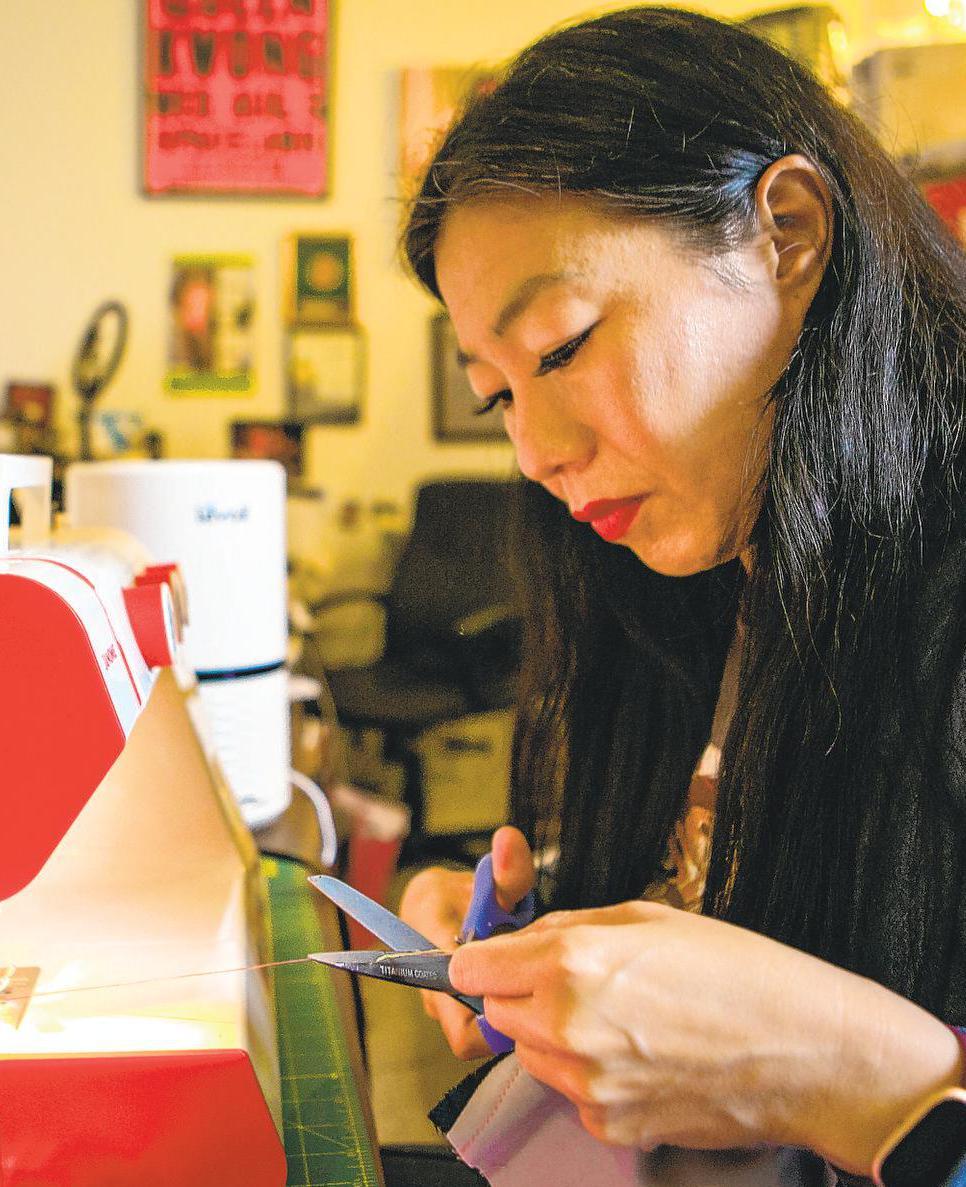
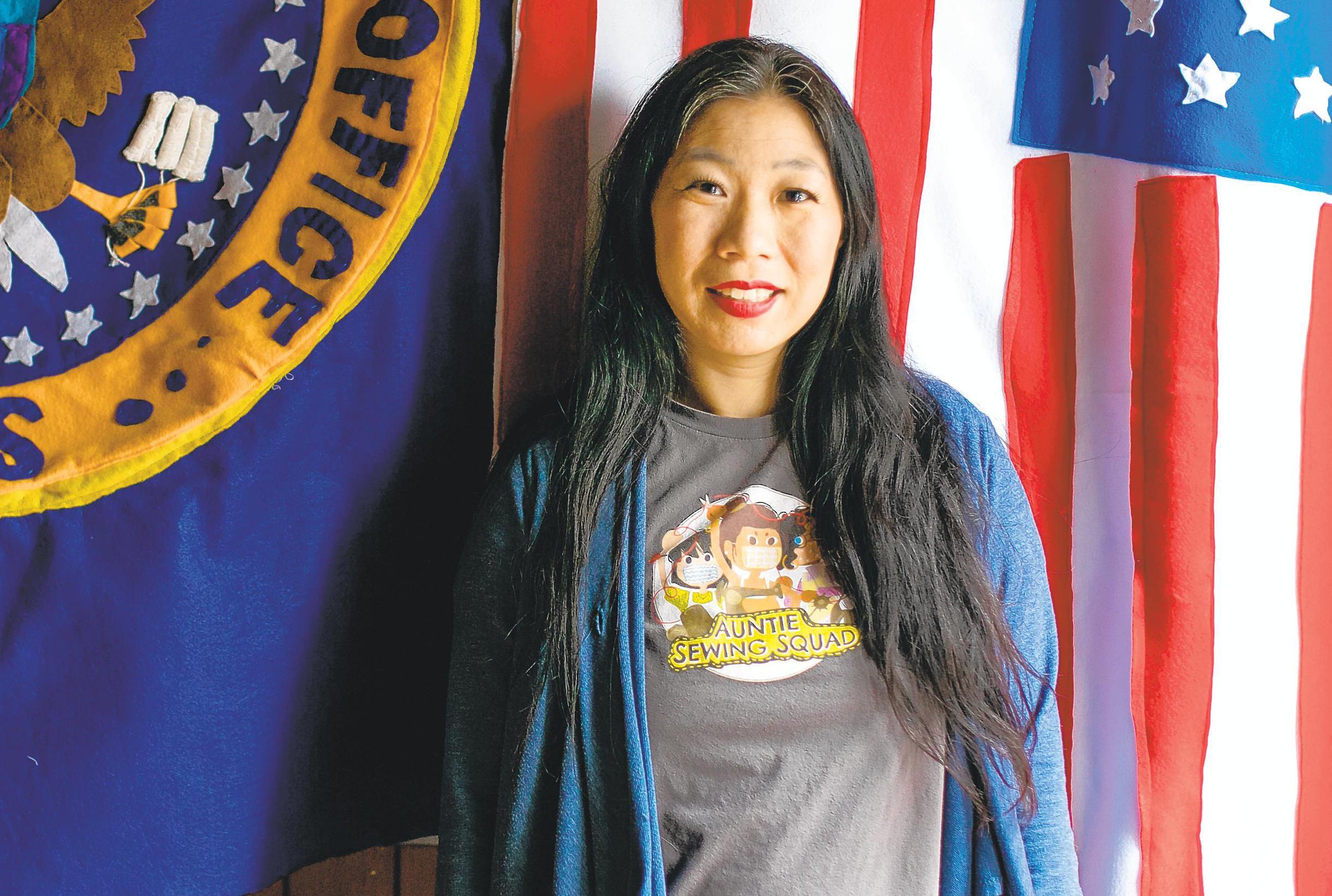
I’m still amazed by
To be in that company ... Tennessee Williams, Thornton Wilder and Kristina Wong? It’s so unreal. Six years ago, my best friend Brian Feldman, who’s also a performance artist, and I submitted our plays for the Pulitzer as a joke, because anyone can, and we could say we were “contenders.” Just the idea of being so close to it was exciting. I got my press pass and prepared three speeches for if I won, lost or was a finalist, but I lost to a play called ‘Hamilton.’ I ended up reading all three speeches on a livestream. My acceptance speech was like, “Screw you, Lin-Manuel.” When I revisited those speeches after becoming a real-life finalist, it
was so strange. So much of my life is a joke.”
Q:How did maskmaking mushroom from just you into a Facebook group project?
A: Four days after I posted online that I could make masks for people, apparently all the people who had been avoiding seeing my theater shows were able to find me on the Internet and ask me for a mask. I kept saying yes. I overpromised the Internet, and I needed to f ind some people to come help me so we could fill the requests and I could quietly go away.
Q:How did you become a “sweatshop overlord”?
A: The moniker Sweatshop Overlord” came from me, a few days into the process, when I said to the friends in my group, “I’m running a sweatshop,” and that became my nickname. When summer schools got canceled during the pandemic, I made a joke to parents that instead of summer school your children can learn to work heavy machinery and make medical equipment.
I made child labor a joke, but it became a reality.
Q:How was the “Auntie Sewing Squad” born, and what’s an “Auntie”?
A: When I was trying to f igure out what to do, I looked on Facebook and found all these existing mask-making groups that were serious. I didn’t want to imply any professionalism was needed. This was going to be a little thing. It wasn’t until later someone told me about the ASS acronym. That was unintentional humor. An Auntie is a term of respect. I’m getting called an Auntie more and more. It’s a nicer word for spinster, old maid or unmarried woman.
Q:What was it like meeting these women from all over the country and sharing this mission with them?

A: I now have a family all over the country, and half of them I’ve never met before. With how scary it felt at times, we bonded the way soldiers bond.
When you meet someone else who’s willing to sacrif ice so much in a moment for people they don’t know,
they become family.
Q: How did your work running the Auntie Sewing Squad become a play?
A: It started as a freeform Zoom piece from my bedroom, about a month into the Sewing Squad, where I was developing it at that point. The screen would f lash “Day 13” and I’d say where we were at. It was like I was witnessing a war. New York Theatre Workshop opened it off-Broadway last October. It ran for four weeks and was a New York Times Critic’s Pick. This will be the West Coast premiere, and from here I go on to Portland Center Stage (in Oregon) and then to the Center Theatre Group in L.A.
Q: For your last performance art piece, “Kristina Wong for Public Office,” you ran a campaign and wrote about the experi-
ence. Today, you’re an elected representative of Wilshire Center Koreatown Sub-district 5 Neighborhood Council. How does being a politician compare to being an artist and sweatshop overlord?
A: I really have been frustrated with elected office. In the pandemic, we had to postpone meetings for a few months. Artists can just get things done faster. I’m very proud of how we came together. A lot of my background as an artist did show up. Most of the folks who were our Super Aunties were artists. We are an example of what it would look like if a bunch of artists ran FEMA. We’re creative and resourceful. The question I ask in the play is: Am I more effective as a politician or an artist? I feel it’s a combination of the two. Artists are necessary to shift the culture, which is the force that eventually shifts legislation. Artists should still run for office. It’s a big pain and it’s a lot of sifting through garbage, but it has its rewards.
Q: Did the Auntie Sewing Squad experience change how you see yourself?
A: I never saw myself as a leader. The joke in the show is I do solo performance because I don’t drink the Kool-Aid, I serve it. I tend to prefer to work alone, so it was weird that I was in this situation where I was having to deal with all these personalities and manage all these emotions. It was a strange time, but I did what had to be done. I thought I’d be the one who panicked in the situation, but it was this moment of chaos where if you showed any inkling you had any idea what to do, people would gravitate to you. I joke that I’m this self-absorbed performance artist, and it turned out I had empathy. A theme in a lot of my shows is that I’m this martyr named Kristina Wong who embarks on these crazy ideas to help people and get way deep in. This one was one of those, too, but I felt like I could not g ive up.
Q: Congratulations on your Pulitzer honor. What did it feel like when you got the news?
A:
it.
“‘Sweatshop Overlord’ came from me, when I said to the friends in my group, ‘I’m running a sweatshop,’ and that became my nickname.”Performance artist Kristina Wong, at her home (above) and with her Hello Kitty sewing machine
“Big Sky Kitchen With Eduardo Garcia”: Magnolia Network, 2 p.m. New series.
In this half-hour series, Montana-based chef Eduardo Garcia invites viewers into his kitchen, where he prepares home-cooked meals drawn from his unique Latin and Jewish heritage, using fresh, locally sourced ingredients.
“Mastermind of Murder”: Oxygen, 7 p.m. Season finale. Season 2 of this true-crime docuseries comes to a conclusion with “Under Covers.” In it, when a woman is shot in her home, her killer comes forward with a story of an assassination plot.
“Love’s Sweet Recipe”: UPtv, 7 p.m. Original film. After her father’s passing, Chef Courtney (Megan Hutchings) works to keep his restaurant from running into the ground. With the help of her childhood friend, Jake (Damon Runyan), and armed with a family heirloom her father left behind called the “Rule Book of Love,” Courtney also finds love in the place she least expects.
60 Minutes: CBS, 7:30 p.m. Season premiere.
“The U.S. and the Holocaust”: PBS, 8 p.m. New series. This documentary from Ken Burns, Lynn Novick and Sarah Botstein explores America’s response to the Holocaust, shedding light on what the U.S. government and the American people knew and did, or didn’t do, as the catastrophe unfolded in Europe. “History cannot be looked at in isolation,” Burns explains.
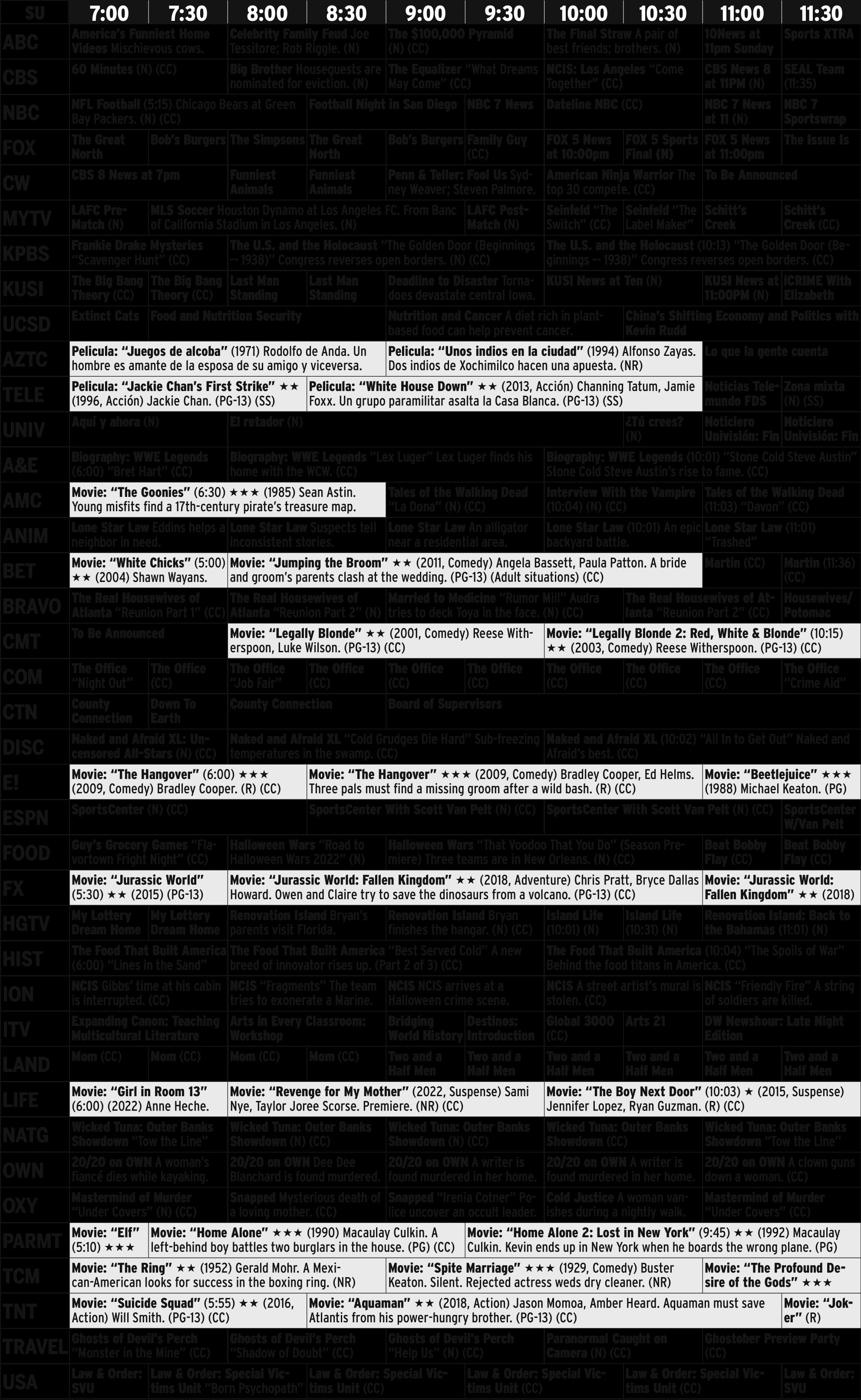
“While we rightly celebrate American ideals of democracy and our history as a nation of immigrants, we must also grapple with the fact that American institutions and policies, like segregation and the brutal treatment of Indigenous populations, were influential in Hitler’s Germany. And
it cannot be denied that, although we accepted more refugees than any other sovereign nation, America could have done so much more to help the millions of desperate people fleeing Nazi persecution.” The film airs over three evenings beginning tonight, then continuing Tuesday and Wednesday (Sept. 20 and 21). The initial installment, “The Golden Door (Beginnings-1938),” chronicles how Congress passed its first laws restricting immigration after decades of maintaining open borders, while in Germany, Hitler and the Nazis began their persecution of Jewish people, causing many to flee to other countries, including America.
“The Neighborhood”: CBS, 8 p.m. Season premiere. In the Season 5 premiere “Welcome Back to the Neighborhood,” Dave (Max Greenfield) decides to disconnect the Johnson home from the grid and inadvertently causes a communi-
tywide power outage.
“Street Outlaws: No Prep Kings”: Discovery Channel, 8 p.m. Season premiere. America’s fastest street racers are back in Season 5 of this series, and the stakes are higher than ever with 15 events, souped-up cars and new drivers taking the wheel to win the ultimate prize of $900,000. Immediately following the season premiere is the series premiere of the “No Prep Kings” spinoff “The Great 8,” in which the top eight drivers in the points standings compete for $15,000 and an additional 20 points toward the No Prep Kings championship.
“Dancing With the Stars”: Disney+, 8 p.m. Live. Season premiere. Season 31 of “Dancing With the Stars” began Sept. 19, moving from its longtime broadcaster ABC to its new exclusive home on Disney+, becoming the streamer’s first live series.
Tyra Banks returns for her third year as host, joined by
new co-host Alfonso Ribeiro, who was the Season 19 champion. Carrie Ann Inaba, Len Goodman, Derek Hough and Bruno Tonioli are back as judges. This season’s celebrity dancers are Joseph Baena, Selma Blair, Wayne Brady, Sam Champion, Charlie D’Amelio, Heidi D’Amelio, Jessie James Decker, Trevor Donovan, Daniel Durant, Teresa Giudice, Vinny Guadagnino, Cheryl Ladd, Jason Lewis, Shangela, Jordin Sparks and Gabby Windey. Episodes livestream Monday nights.

“The Voice”: NBC, 8 p.m. Season premiere. The hit singing competition series returns for its 22nd cycle, with Gwen Stefani returning as a judge after skipping last season. Stefani reunites with returning judges John Legend and Blake Shelton, and they’ll all be joined by newcomer Camila Cabello. Carson Daly once again hosts. Two-hour episodes air Mondays starting tonight; follow-ups air Tuesdays.
“Bob Hearts Abishola”: CBS, 8:30 p.m. Season premiere. Abishola (Folake Olowofoyeku) and Kemi (Gina Yashere) hatch a plan to keep Ebun (guest star Saidah Arrika Ekulona) and Pastor Falade’s (guest star Jonathan Adams) flirtation from growing in the Season 4 premiere “Touched by a Holy Hand.”
“NCIS”: CBS, 9 p.m. Season premiere. Season 20 of “NCIS” premieres tonight with an “NCIS: Hawai’i” crossover event. In “A Family Matter,” Special Agent Alden Parker (Gary Cole) is still on the run with his ex-wife Vivian (guest star Teri Polo), so the team gets help from Special Agent Jane Tennant (guest star Vanessa Lachey) to investigate who from Parker’s past might have a personal vendetta against him.
“The Cleaning Lady”: Fox, 9 p.m. Season premiere. The crime drama begins Season 2 with “Sins of the Father,” in which Thony (Élodie Yung) is desperately trying to find her son, Luca (Sebastien and Valentino LaSalle), after he was kidnapped by his father, Marco (guest star Ivan Shaw).
“The Bachelorette”: ABC, 8 p.m. Season finale. The second part of Season 19’s twopart finale sees Gabby deciding whether or not to get engaged to Erich while Rachel chooses between Aven and Tino.
“FBI”: CBS, 8 p.m. Season premiere. In the Season 5 premiere “Hero’s Journey,” the team pivots when their sting operation to secure a massive bomb from an illegal broker leads them to discover that the device is already in the wrong hands.
“FBI: International”: CBS, 9 p.m. Season premiere. In “Unburdened,” the Season 2 premiere, Megan “Smitty” Garretson (new regular cast member Eva-Jane Willis) of Europol assists with investigating the murder of an American detective in Paris who was hunting illegal weapons dealers.
“Monarch”: Fox, 9 p.m. Part 2 of the series’ premiere continues to follow country music’s royal family — the Romans (Susan Sarandon and Trace Adkins) — who are trying to maintain the dynasty they built. Their heir to the crown, daughter Nicky (Anna Friel), will stop at nothing to protect her family’s legacy, while ensuring her own quest for stardom.
“FBI: Most Wanted”: CBS, 10 p.m. Season premiere. When a family of four from New York is found dead in a Georgia motel room, the Fugitive Task Force investigates a connection between the victims and the sale of illegal firearms in the Season 4 premiere “Iron Pipeline.”
“The Conners”: ABC, 8 p.m. Season premiere. Season 5 of the “Roseanne” spinoff picks up after Darlene (Sara Gilbert) and Ben (Jay R. Ferguson) decided to build a new house and let Becky (Lecy Goranson) move in with them in the Season 4 finale. What is the reality of those three living together going to be like? John Goodman, Laurie Metcalf and Emma Kenney also star.
“Survivor”: CBS, 8 p.m. Season premiere. Jeff Probst returns as host for “Survivor’s” 43rd season as 18 new castaways compete for a $1 million prize in Fiji. The season begins with a two-hour premiere tonight.
“The Goldbergs”: ABC, 8:30 p.m. Season premiere. Big changes are in store for Season 10 of this sitcom set in the 1980s. First, George Segal, who played Pops, passed away in 2021. Then, Jeff Garlin (Murray) was let go following misconduct allegations. Murray will be written out early on in the new season. Expect Season 10 to deal with Beverly’s (Wendi McLendon-Covey) status as an empty nester now that Adam (Sean Giambrone) has graduated high school.
“Abbott Elementary”: ABC, 9 p.m. Season premiere. The critically praised mockumentary-style sitcom set in an inner-city grade school moves to Wednesdays and has a full 22-episode order for Season 2. Creator and star Quinta
Brunson said the new season will go outside the school more. She also teased several cameos, including one from a big star in the first episode.
Sheryl Lee Ralph, Chris Perfetti, Janelle James and Tyler James Williams also star.
“Lego Masters”: FOX, 9 p.m. Season premiere. Host Will Arnett is back with Brickmasters Amy Corbett and Jamie Berard for Season 3 of the Lego building competition, beginning with the spacethemed episode “Ready to Launch.” This season also includes an incredible treehouse challenge and a Lego dog show. The winning team gets a $100,000 cash prize, the ultimate Lego trophy and the title of Lego Masters.
“Celebrity Family Feud”: ABC, 8 p.m. Season finale. The cast of Jackass, led by Johnny Knoxville and Jeff Tremaine, battle it out to see who will win the grand prize for their selected charities in the Season 8 finale of the game show hosted by Steve Harvey.
“‘Law & Order’ Franchise Special Primetime Block”: NBC, beginning at 8 p.m. Season premieres. Tonight’s special programming event brings back “Law & Order,” “Law & Order: Special Victims Unit” and “Law & Order: Organized Crime” for new seasons while bringing all three of the casts together for the first time through interwoven plotlines over a three-hour telecast. The event begins with “Organized Crime’s” third season premiere, “Gimme Shelter,” continues with the “Special Victims Unit” Season 24 premiere, “Gimme Shelter — Part Two” and concludes with “Law & Order’s” Season 22 premiere, “Gimme Shelter — Part Three.”
“Norman Lear: 100 Years of Music and Laughter”: ABC, 9 p.m. The life and legacy of storyteller, activist and philanthropist Norman Lear is honored at this one-night-only celebration of his 100th birthday. The special pays homage to the man behind some of television’s greatest stories and features a lineup of celebrity guests and musical performances.
“Shark Tank”: ABC, 8 p.m. Season premiere. More budding entrepreneurs will have the chance to pitch their business or product to the Sharks — tough, self-made multimillionaire and billionaire tycoons — in Season 14 of the reality competition show, hoping that one of them will invest and help grow the business.
“Killer Camp”: The CW, 8 p.m. Season finale. As the final day at Camp Pleasant unfolds in the Season 2 finale of this reality series, everyone is a suspect and the campers are on edge. Find out who the killer is in “A Killer Faces the Chop.”
“Secret Celebrity Renovation”: CBS, 9 p.m. Singer, songwriter, dancer, actress and TV personality Nicole Scherzinger gives back to someone special with a surprise home makeover in tonight’s new episode.
“Point of View: A Designer Profile”: Magnolia Network, 1 p.m. New series. In this halfhour docuseries making its linear Magnolia Network premiere, talented interior designers reveal how they create their beautiful work. In today’s installment, Joanna Gaines reflects on her journey to becoming a designer and shares her plans to restore the historic Cottonland Castle in Waco, Texas, which will be the subject of her and her husband Chip’s new series, “Fixer Upper: The Castle,” coming in October.
“Finding Happy”: Bounce TV, 8 p.m. New series.This halfhour comedy follows the Black female experience through the unfulfilled life of Atlanta native Yaz Carter (B. Simone), beginning with her unhappy birthday. The 10-episode first season
Iam shipwrecked.
Well, to be fair, there is no ship. There’s not even a boat or a small dingy. It’s just me, my guide and a cracked paddleboard that’s leaking in water.
Moments before, I was attempting to wade into Playa del Amor (Lovers Beach), a majestically iconic beach at the tip of the Baja Peninsula in Cabo San Lucas. This particular beach on what is called L and’s End, itself known for its limestone rock formations and romantic isolation, is only accessible by water or a rigorous hike. In my case, I have chosen to paddleboard in to the beach just before dawn, doing my best to take in the gorgeous sunrise as I balance on the board.
“ There’s beauty everywhere here,” says my guide at one point as we were paddling near the marina, doing our best to steer clear of the seemingly endless amounts of fishing boats on their way out. “You just need to know where to look.”
Once I’ve collected myself on the shores of Lovers Beach, I find that one of the more amazing distinctions about this particular playa, in addition to its sheer beauty, is the fact that travelers can casually walk from one beach, located on the Sea of Cortez side,
to another beach on the Pacific Ocean side. One is calm and tranquil (the Cortez side) while the other has behemoth waves (Pacific) that, for this novice paddleboarder, were simply too difficult to navigate. This result was that a wave crashed down on me, the undertow pulling me and the board down. I’m shaken but unharmed, but the board is now unusable.
Still, I am lost in the moment. I have the beach all to myself, as it is too early in the day for anyone else to be here. As I aimlessly wander
between the two shores, listening to the nearby barking of sea
it occurs
is something of a perfect metaphor for the Los Cabos region of Baja California Sur. Rather, that this is a region with two distinct vibes, one that is tranquil and untapped (San José del Cabo) and one that is more rollicking and festive (Cabo San Lucas). That whatever San Diego travelers might be seeking, a relaxing sojourn or an active adventure, they can find it here.
In this moment, however, I
must somehow find my way back.
A more mature party Mention Cabo to most U.S. travelers and they’ll likely envision a bustling party town with daydrinking tourists and nighttime revelry. It’s a reputation that isn’t wholly undeserved, but it’s one that’s becoming increasingly outdated.
Over the past few decades, the Cabo region of Mexico has attempted to cater to a more mature clientele. It makes sense: The 20-somethings who once partied
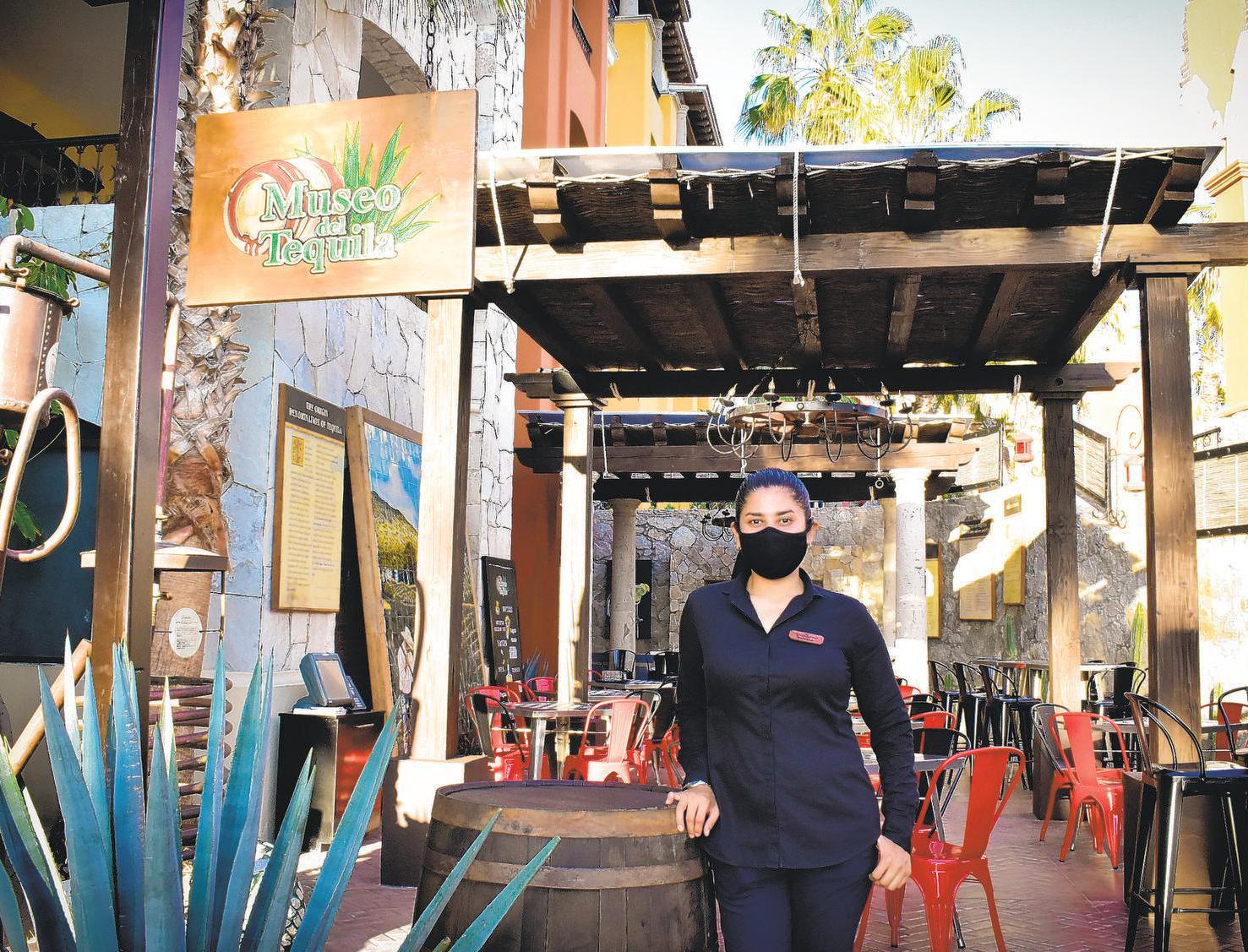
What’s more, getting to Los Cabos has never been easier. Multiple airlines fly direct out of San Diego International Airport for as low as $300 round-trip, but for budget travelers, or those, like me, just looking for a quick getaway, I’d highly recommend flying out of the Tijuana International Airport. I have used the Cross Border Xpress (CBX) land bridge, which connects Otay Mesa directly to the Tijuana airport, several times over the years and have found it to be a convenient and even enjoyable experience at $32 (round trip).
The flight from Tijuana to the Los Cabos International Airport takes a little over two hours. The round-trip price can be as low as $100 if booked well in advance, and it’s still quite affordable at about $200 if travelers are simply looking to get away for the weekend. Of course, prices would increase depending on the month, such as during whale-watching season in November and December.
Once there, it’s about a 30minute drive from the airport to Cabo San Lucas. Just as it is the case with traveling in other parts of Baja, getting a taxi or an Uber from the airport can be an ambiguous undertaking. Most hotels and resorts in Cabo offer shuttle or even individual pickup options from the airport that range from $35 to $50 for one way to $75 to $100 round trip, so travelers should check online for this option.
Once in Cabo San Lucas, there are a plethora of new-ish or re-


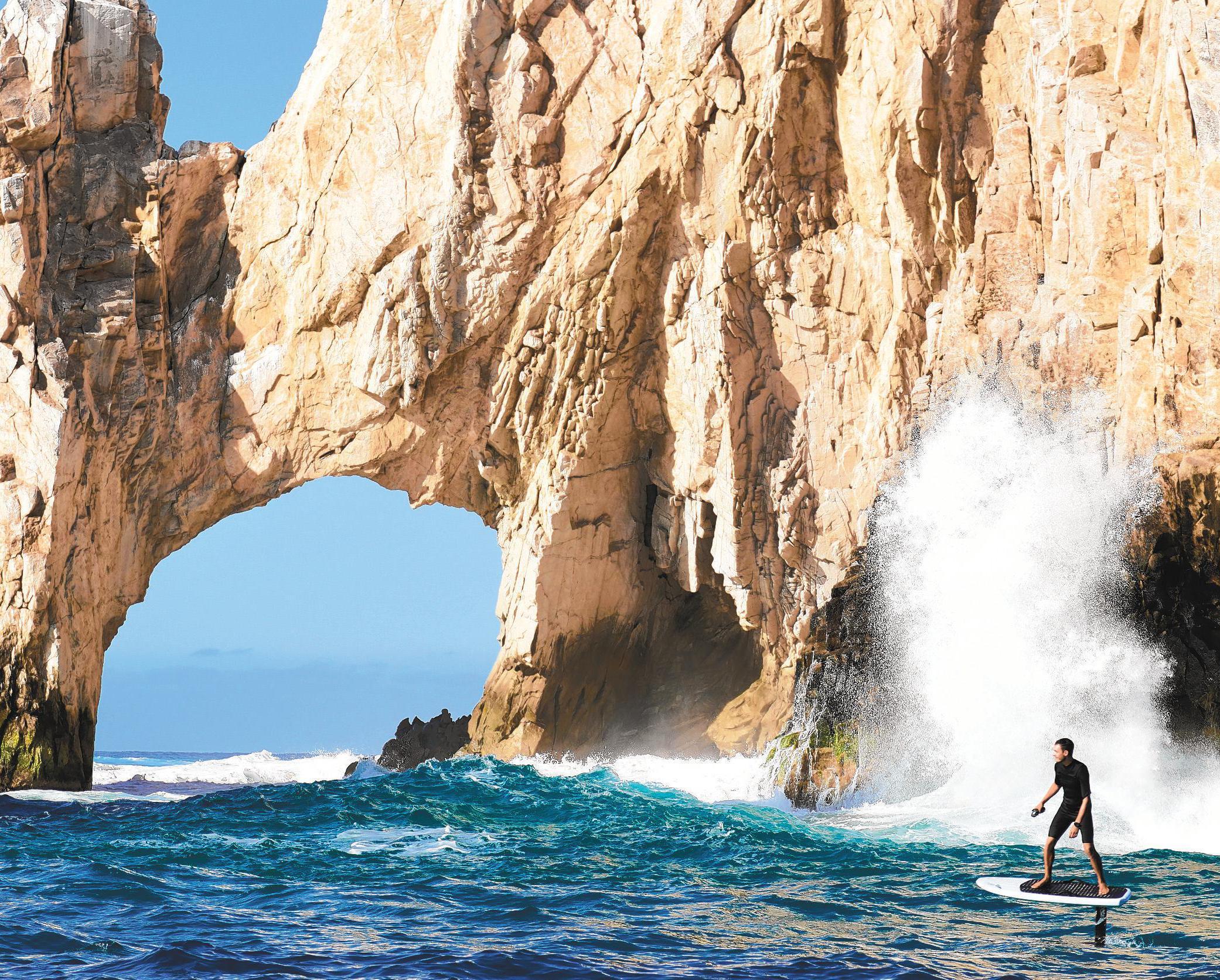
hile only a few miles north of the city, San José may well be its own planet, with its private beaches and scenic cliffs. It’s quickly becoming developed, however, with sprawling resorts popping up and with names like Marquis Los Cabos, Le Blanc Spa Resort and Royal Solaris. But what they all have in common is the idea of seclusion, where guests need not leave the property to find whatever they’re looking for.
Such was the case with Vista Encantada Spa Resort & Residences, a seemingly endless property that opened in 2019 and offers unique amenities in addition to its serene views of the coast. Yes, there’s the pleasant but posh suites, complete with charming artwork on the walls, and a spa that is as multifaceted as it is fancy. But, for me, it was the little things: the quaint little lighthouse on the hill (yes, it’s a functioning lighthouse), the charming chapel on the cliff and the property’s Museo del Tequila, complete with an on-site sommelier. That somm, Consuelo Cervantes Viveros, was highly knowl-

edgeable of not only the liquor, but of food and fruit pairings for each bottle. She even offered visitors some sal de gusano (a dried and ground mix of salt, chiles and ground agave worms). It was these types of interactions that I found to be a charming, more intimate alternative to the bustle of Cabo San Lucas.
the corner
With its many scenic beaches, vistas and rock

formations, not to mention the many culinary and nightlife offerings, it’s easy to forget that most of the Los Cabos region is mostly made up of nature preserves and national parks. Both the Sierra de la Lag una mountain range and Cabo Pulmo National Park are protected natural areas with a few hiking trails. The latter is a sprawling, gorgeous marine reserve (I’d recommend going after January for whale watching) while the latter is an
arid but richly biodiverse park that, however rugged, is great for rare bird-watching.
Both parks are easy to access via the bus, but I would recommend hiring one of the many guides that are easily found on a walk around the aforementioned marina. In addition to the restaurants and shopping, the marina is loaded with kiosks offering day-tripstyle adventures; from parasailing and fishing tours to scuba diving and
nees. My concierge at Corazón recommends a local company called Cabolectric for something called an eFoil board experience, the only company in Cabo to offer it. EFoil boards are essentially an electric surfboard that has a remote-controlled propeller in the back. For those who, like myself, failed to ever find their surfing legs, I cannot recommend the Cabolectric eFoil experience enough. Once I got the hang of it, I was zipping around the ocean with abandon, leaning from side-to-side to steer while doing my best to not lose my balance (the handheld remote cuts the engine off as soon as the rider hits the water).
I had so much fun, I booked the same company for what would become my doomed paddleboard experience.
Beauty everywhere Back on Lovers Beach, I’m already not loving the idea of having to paddle back with two people on one board with another board jury-rigged between us and still leaking water. I
excursions. The beach I’m standing on, the iconic arch (about which experts are now saying that its days are numbered after a recent earthquake) and the sunrise in the distance more than make up for any mishaps.
About a quarter of the way back, with my arms feeling as strained as a lump of spaghetti, a fisherman takes pity on us and lets us jump onto his boat along with the boards and we head back to the comforts of the Cabo San Lucas shores. My guide apologizes again.
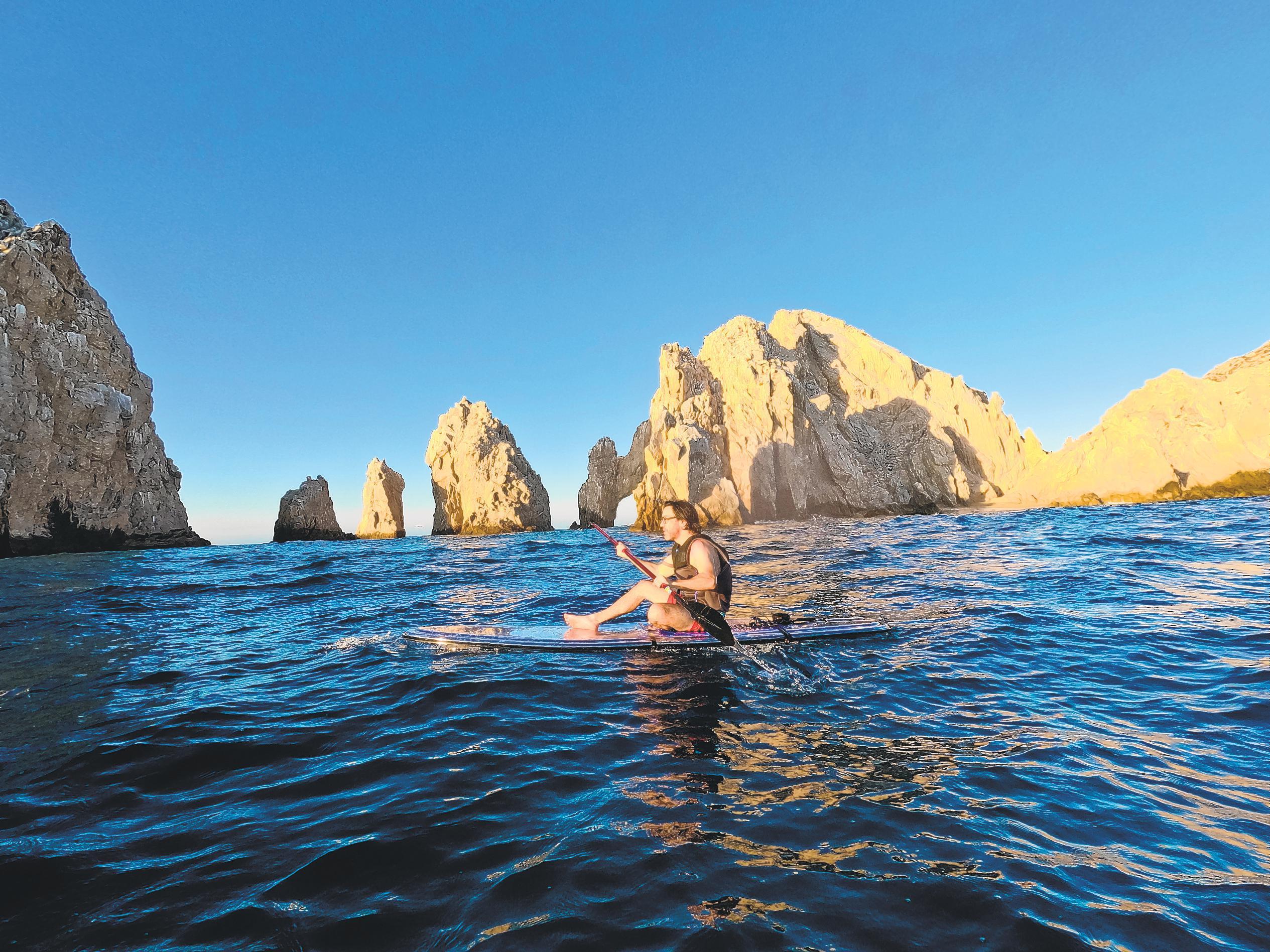
Are you kidding?” I ask.
“ That was awesome. Plus, it was a real adventure. We pulled together and figured it out. So really, thank you.”
He smiles and agrees, but I can tell he still feels bad.
“What did you tell me earlier?” I ask. “That there’s beauty everywhere if you know where to look? That’s what this is.” He agrees as the boat pulls in and we begin to wade to shore.